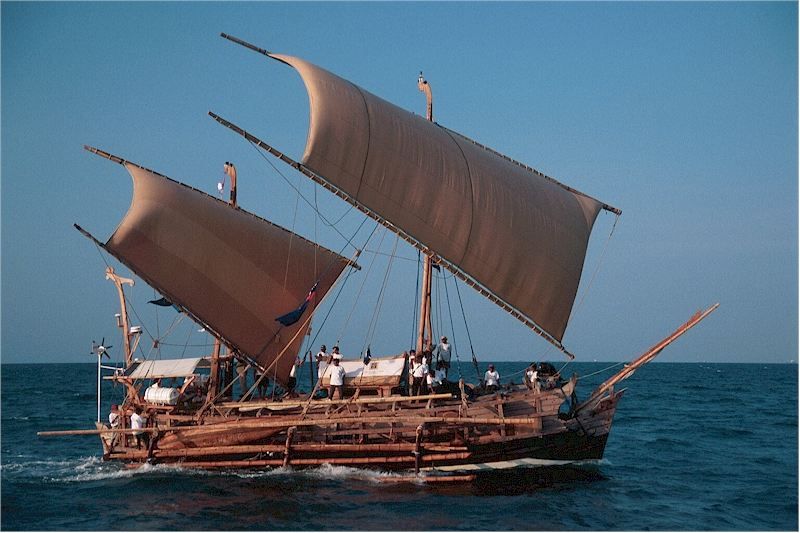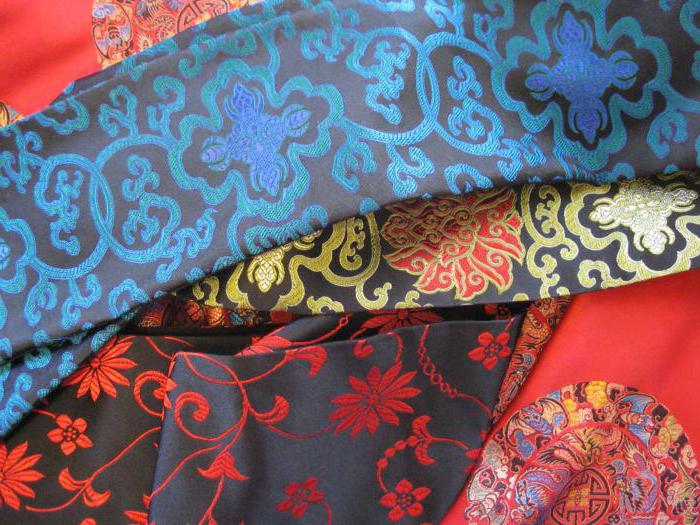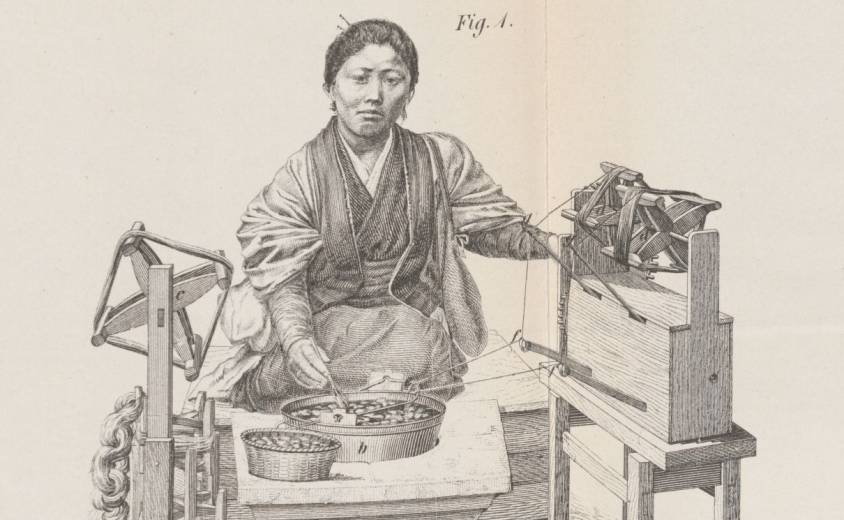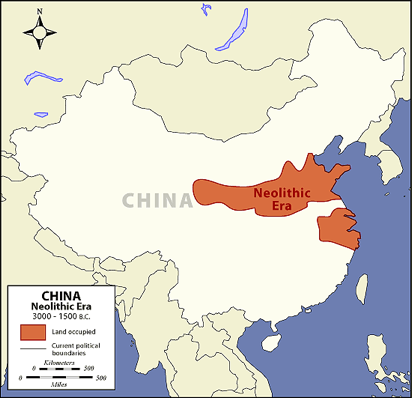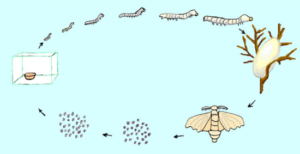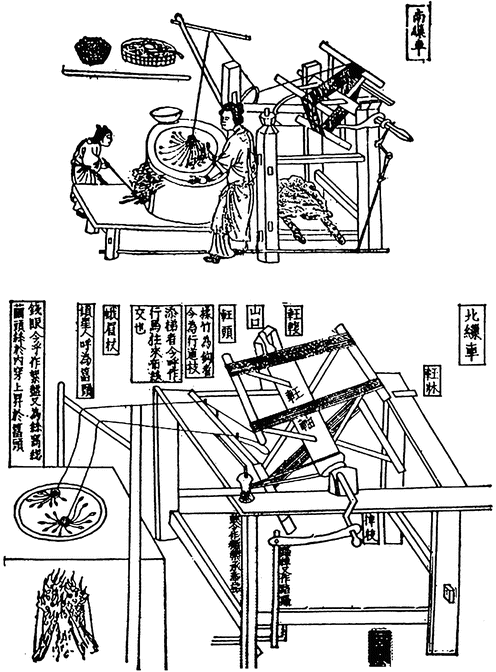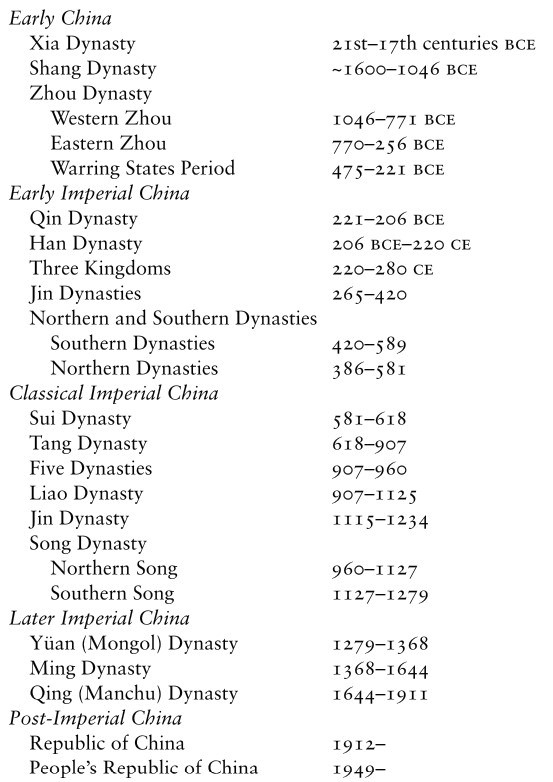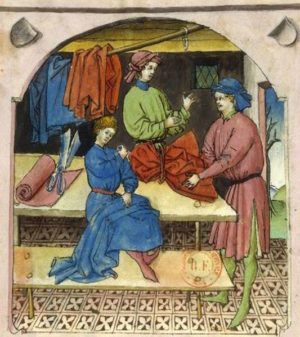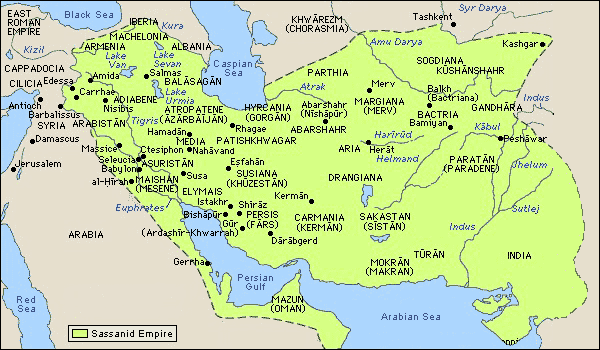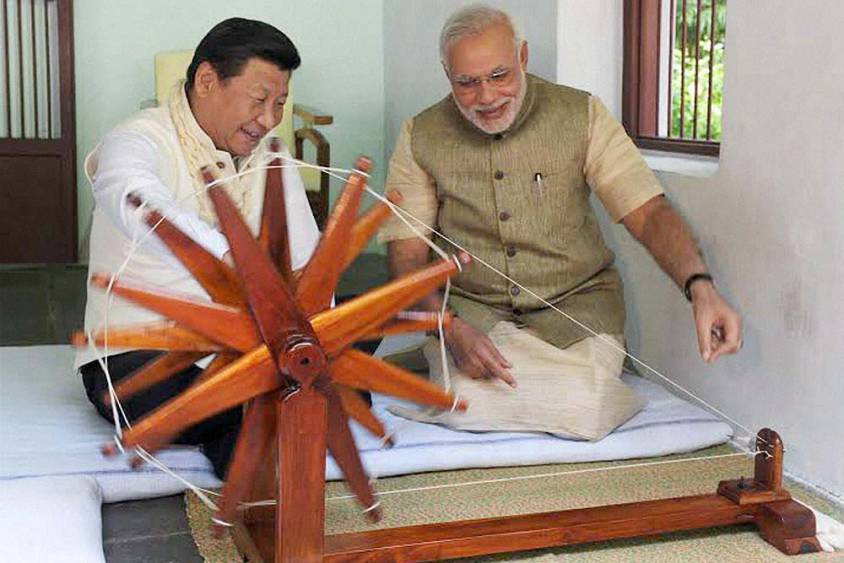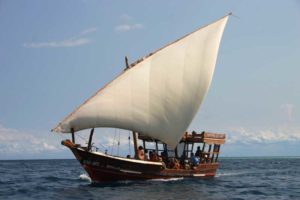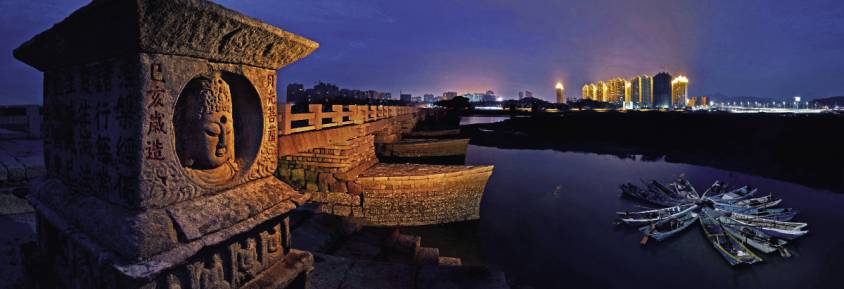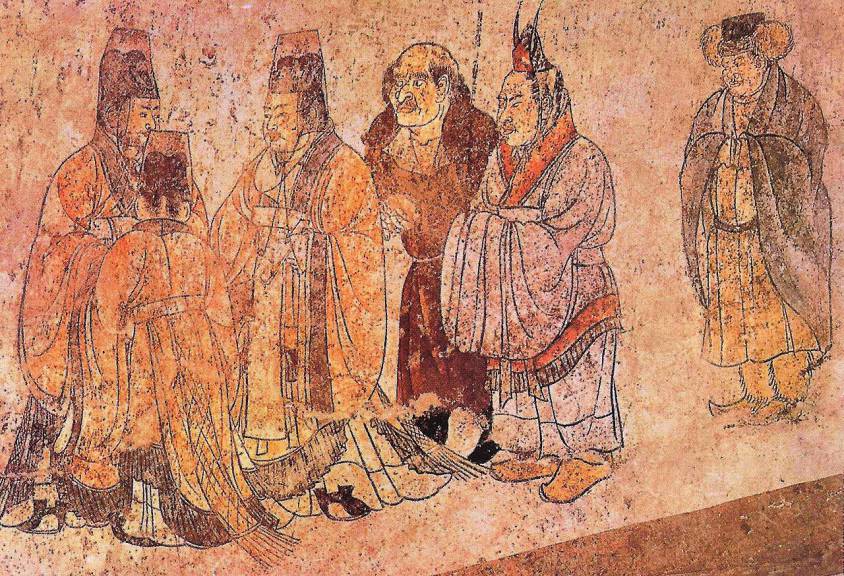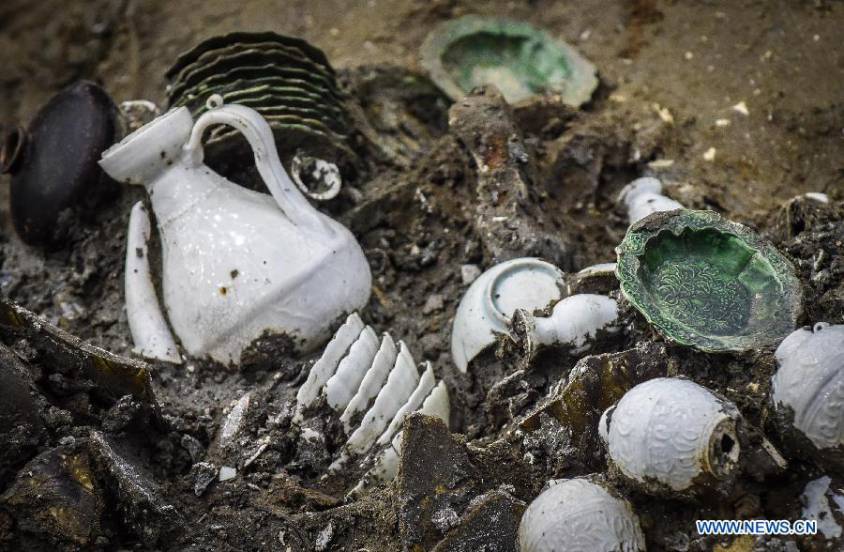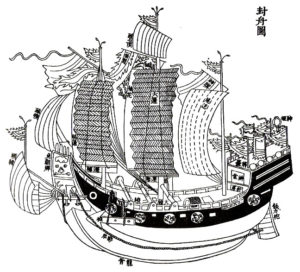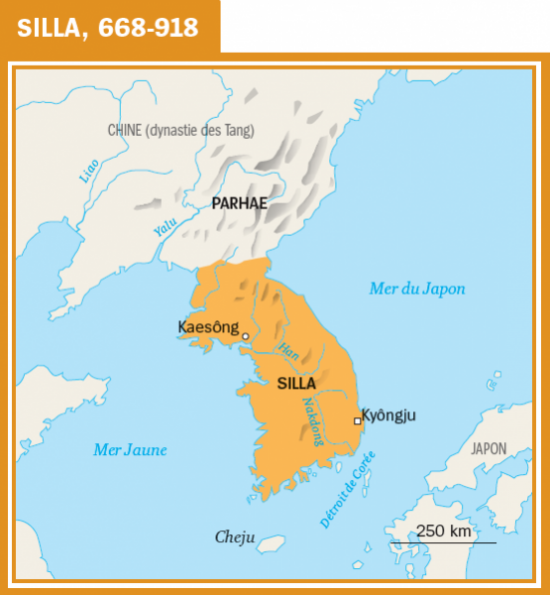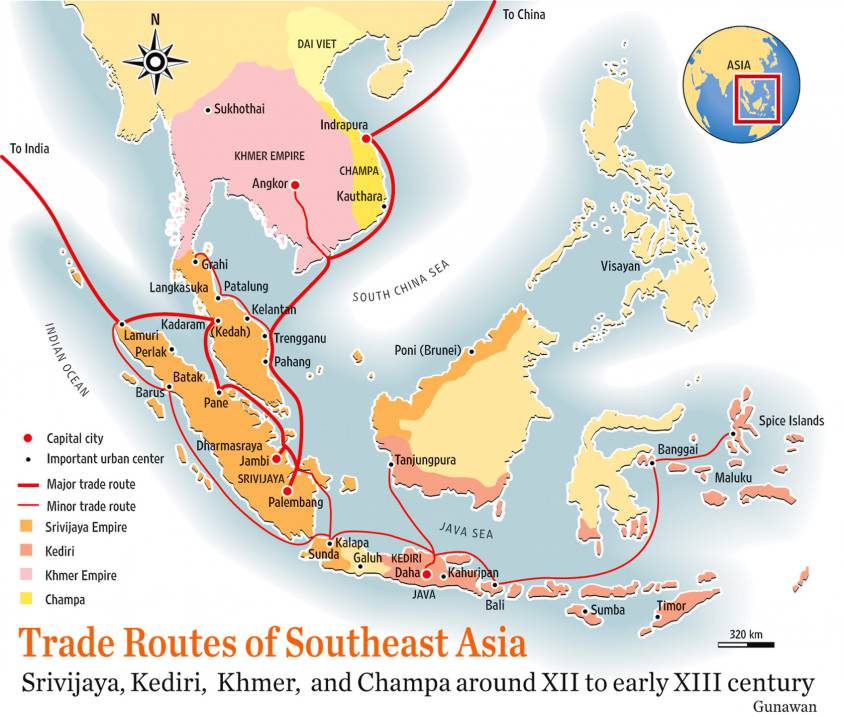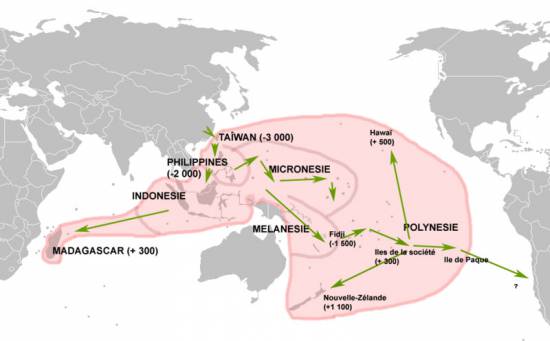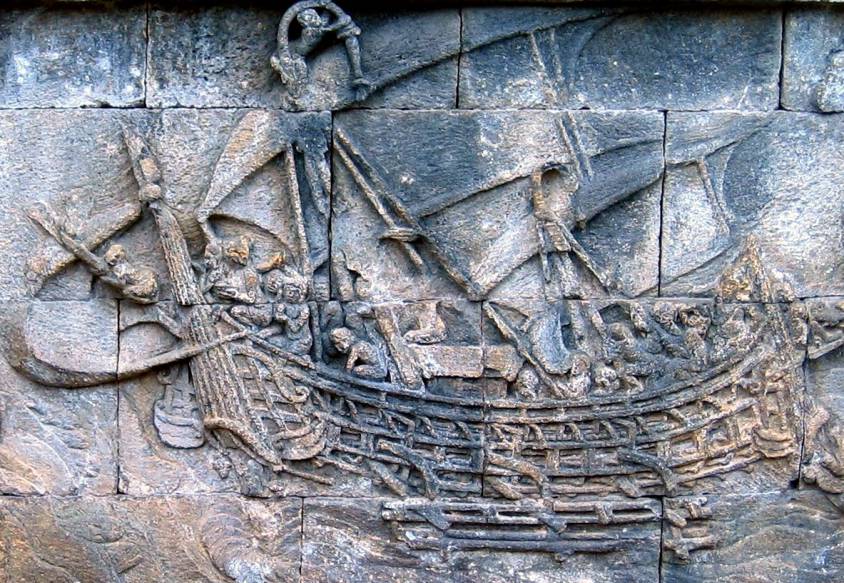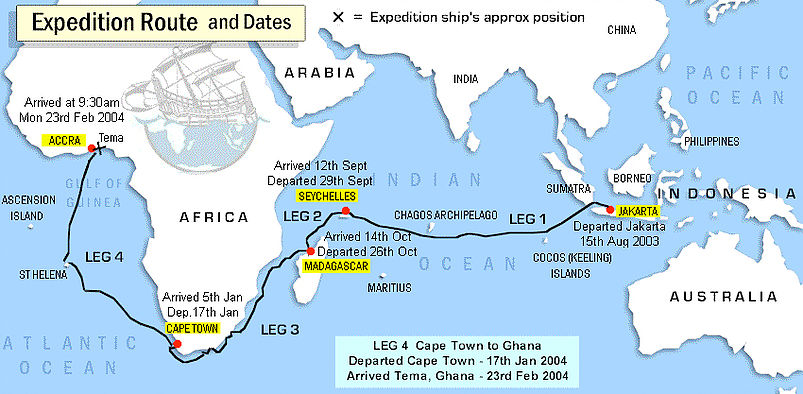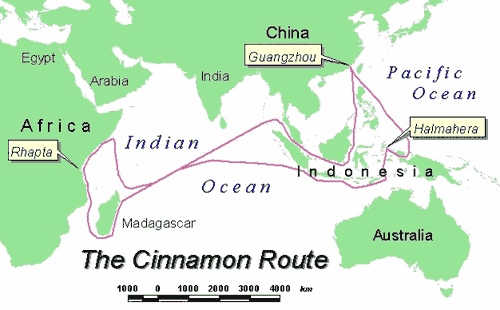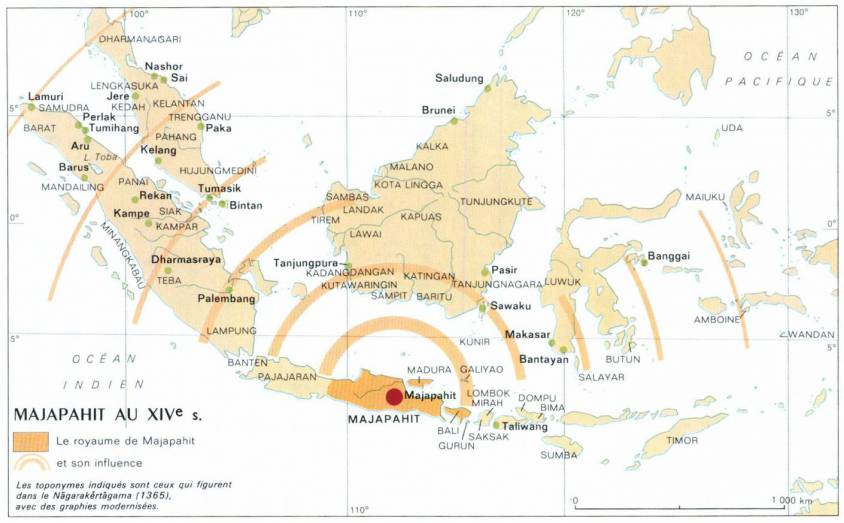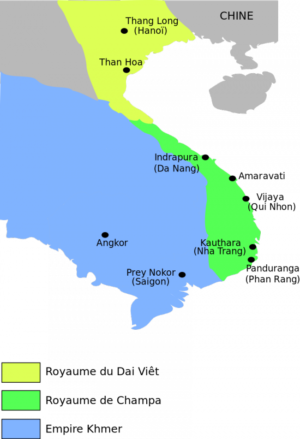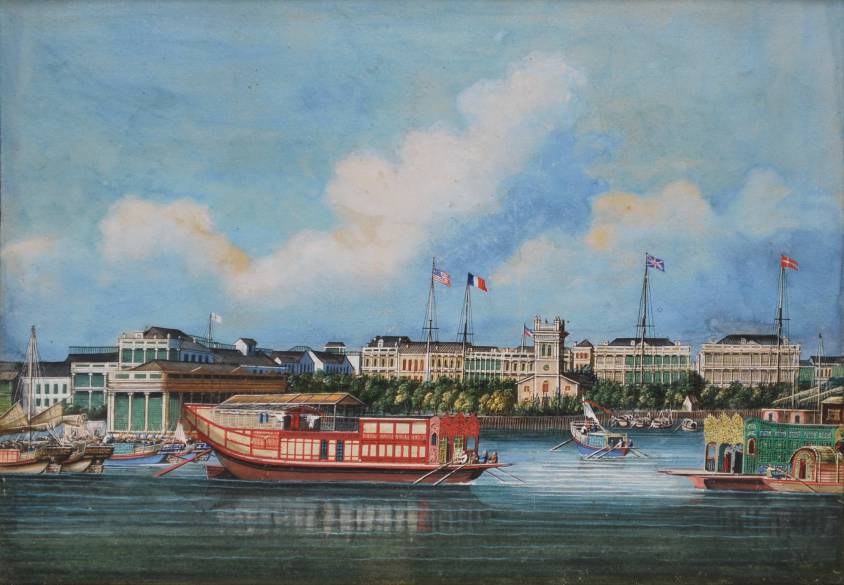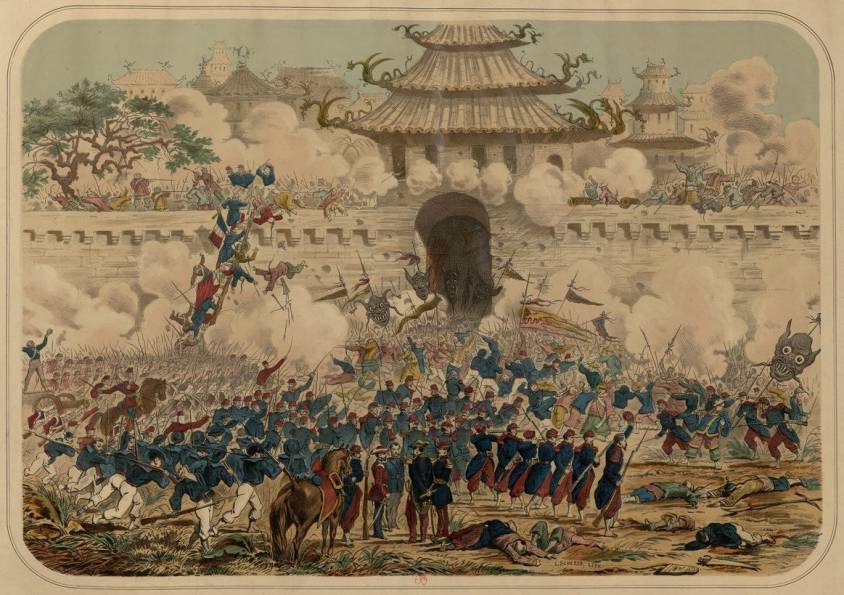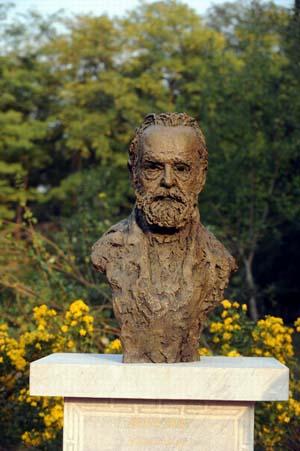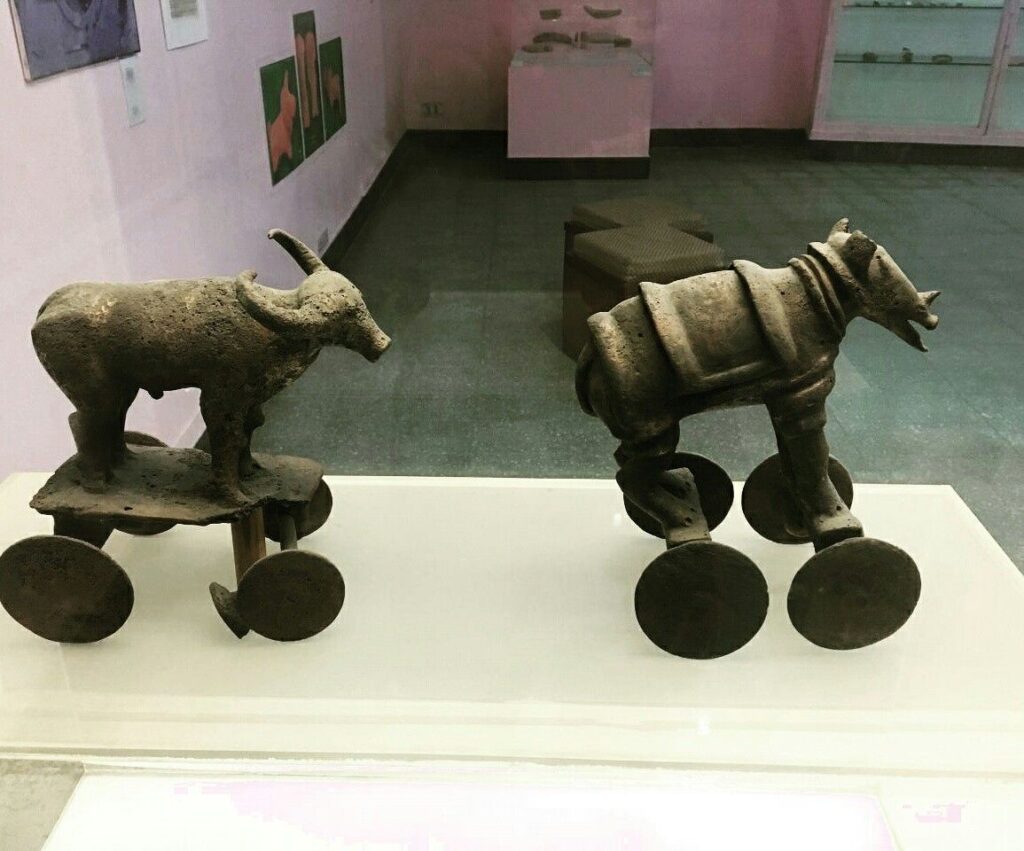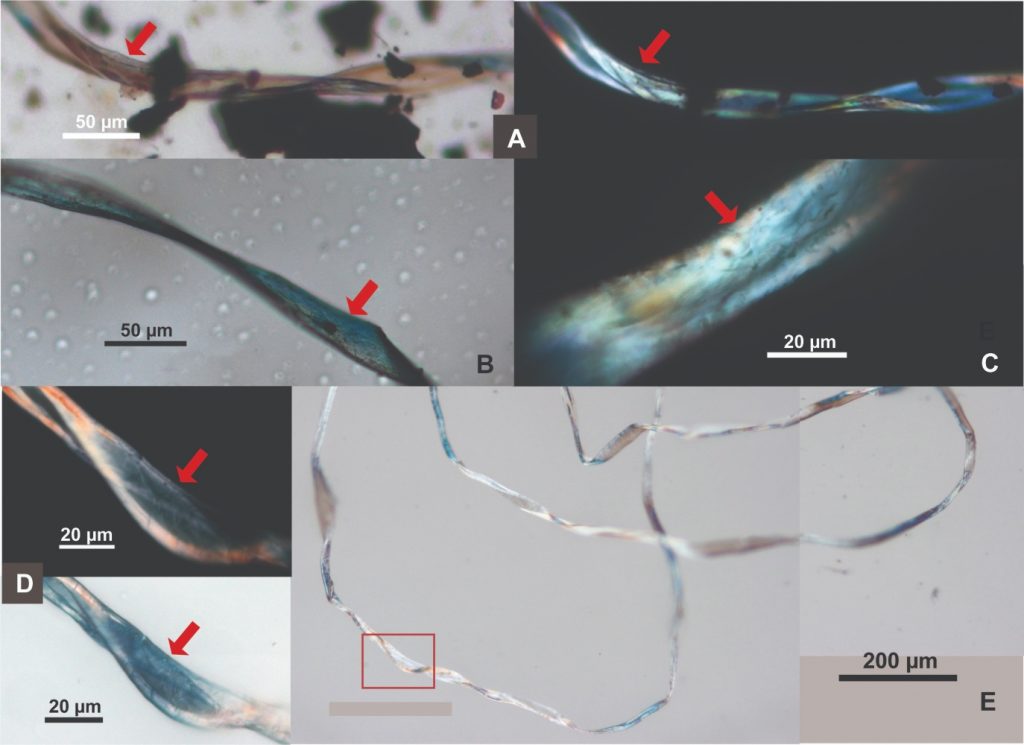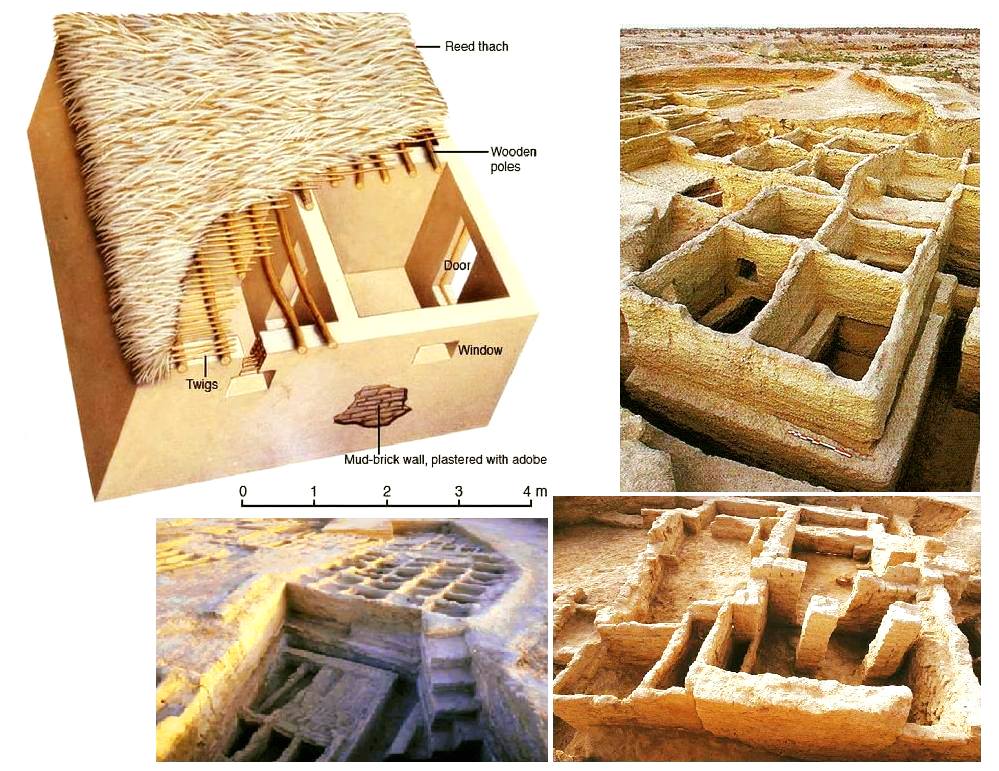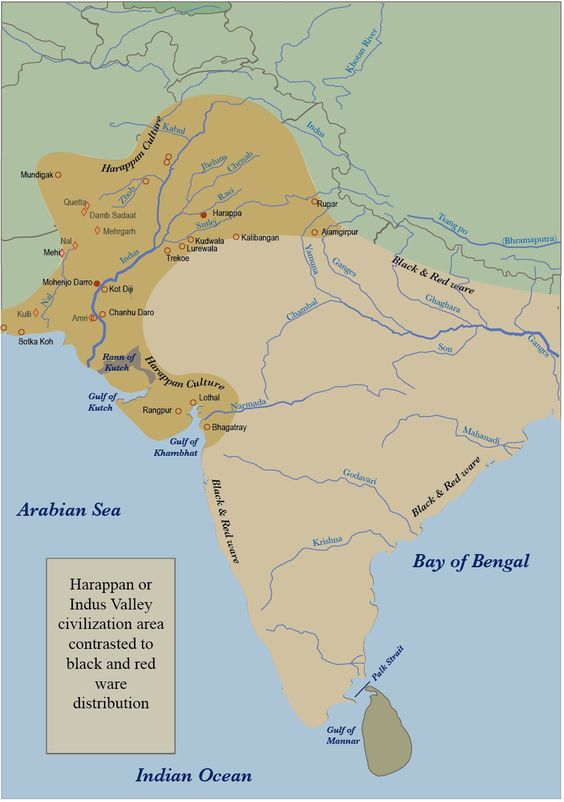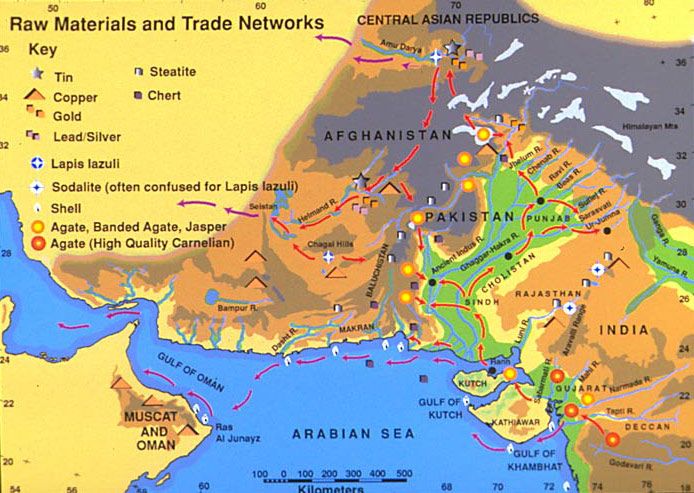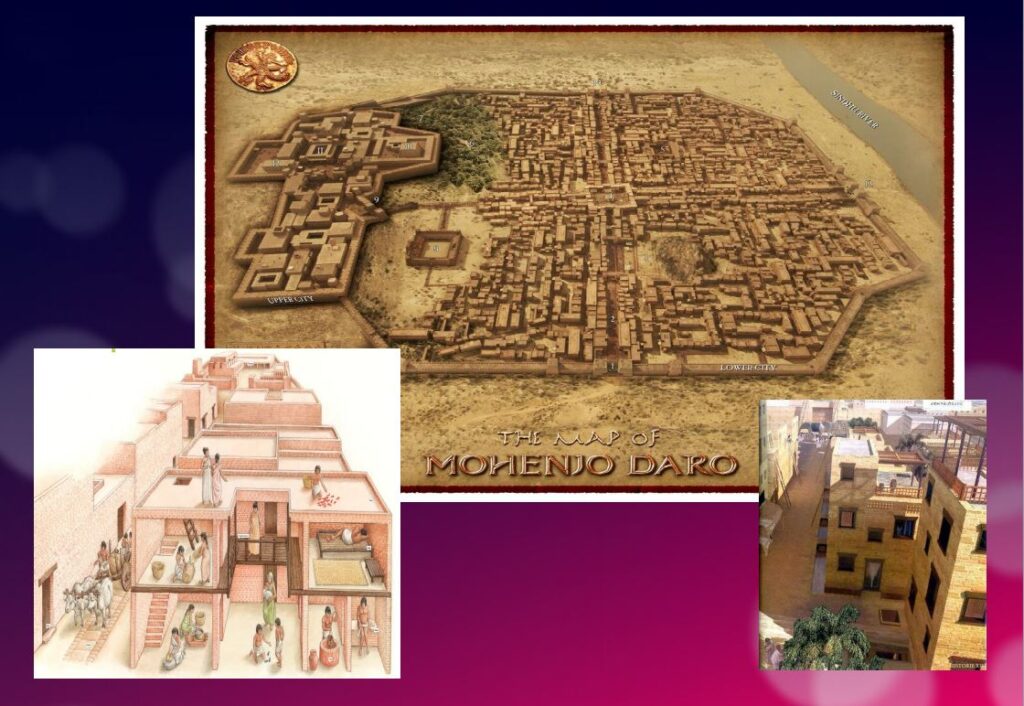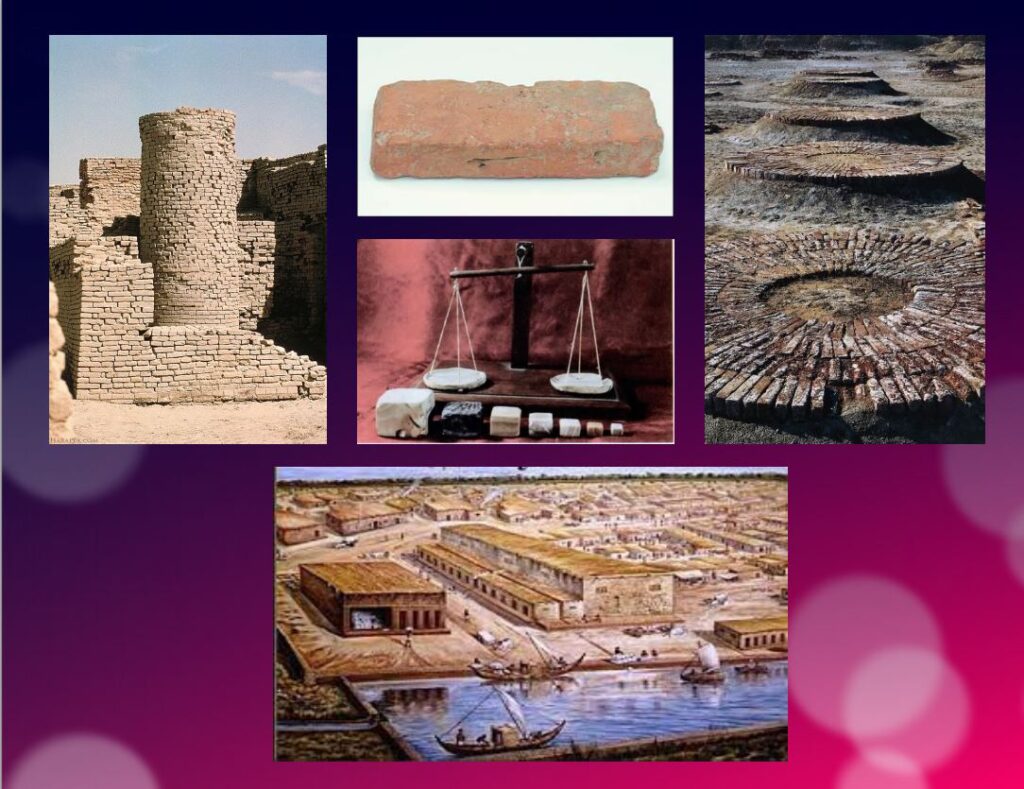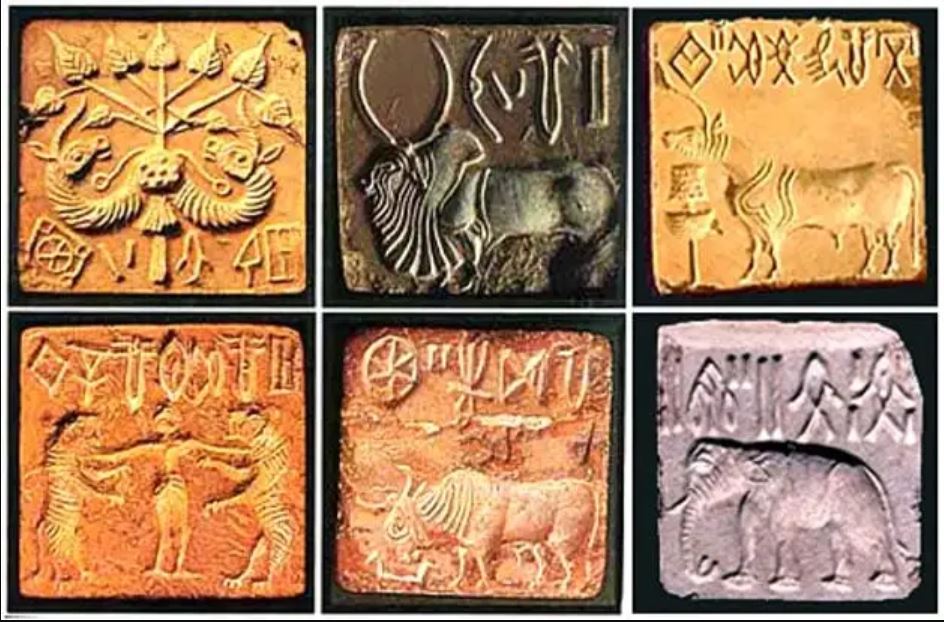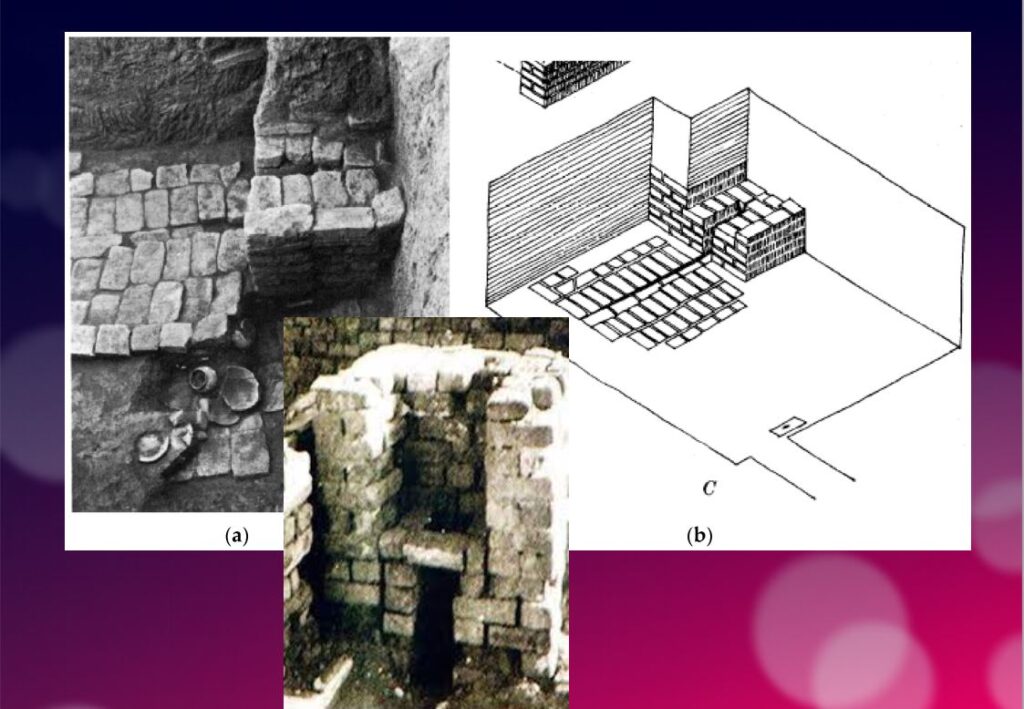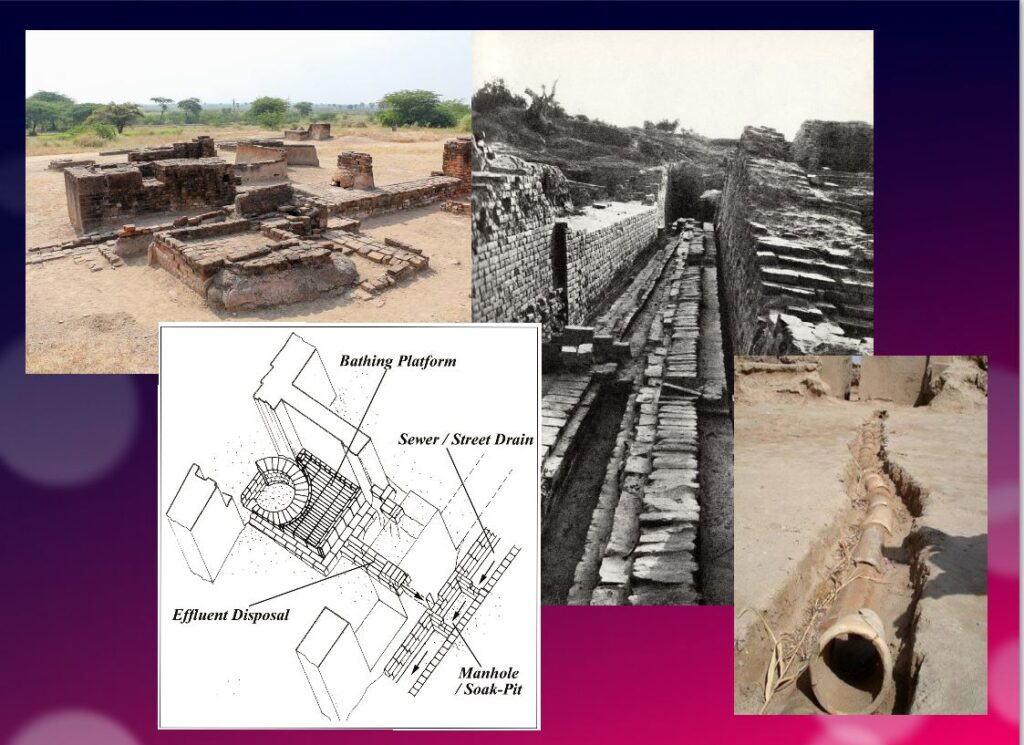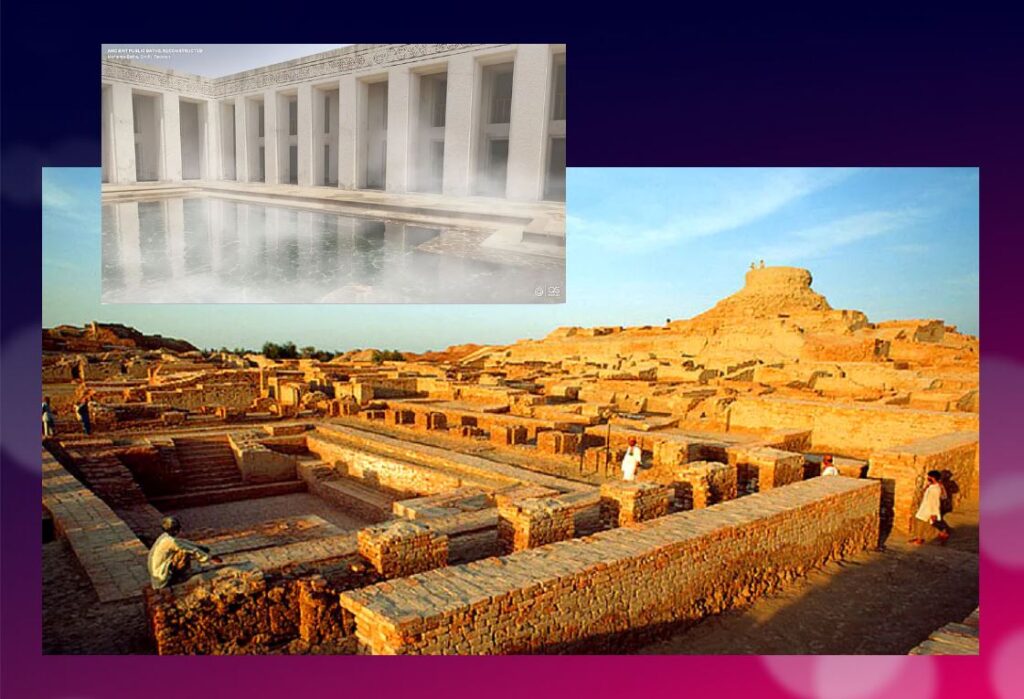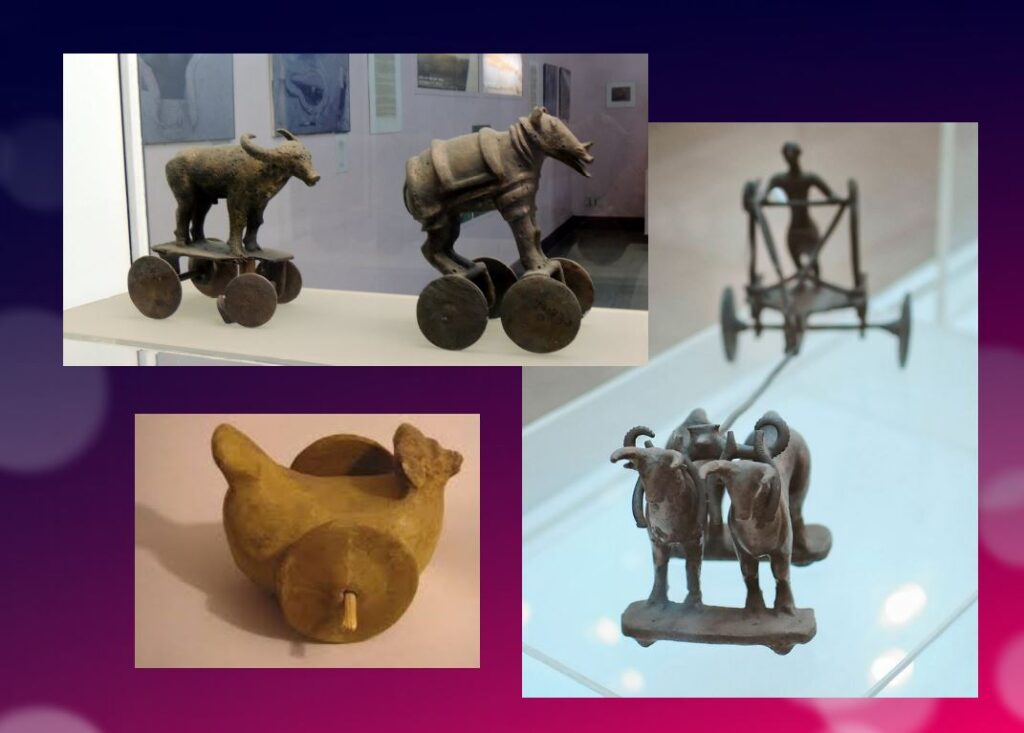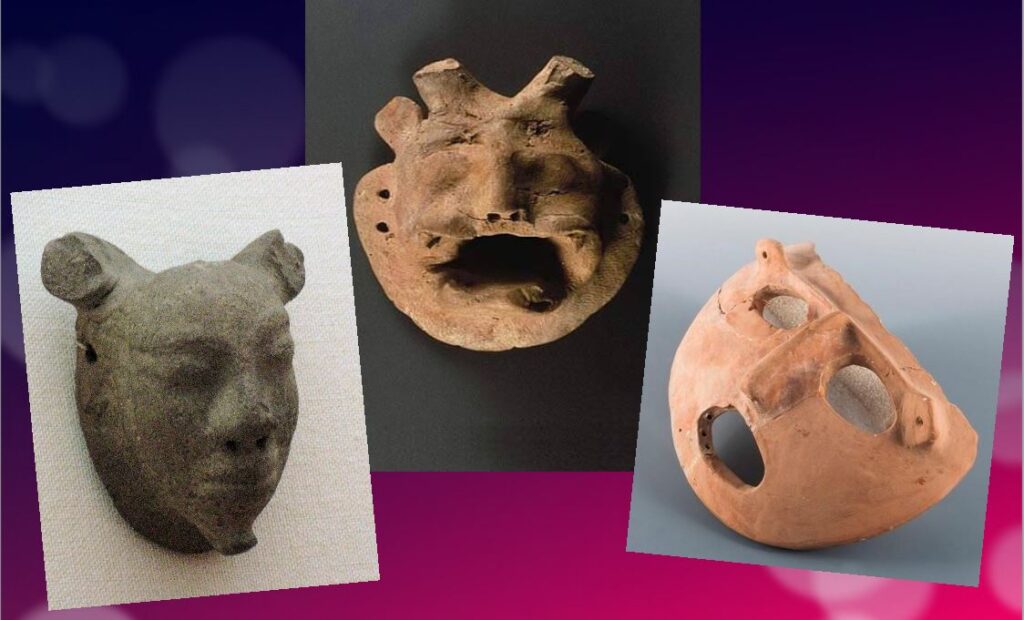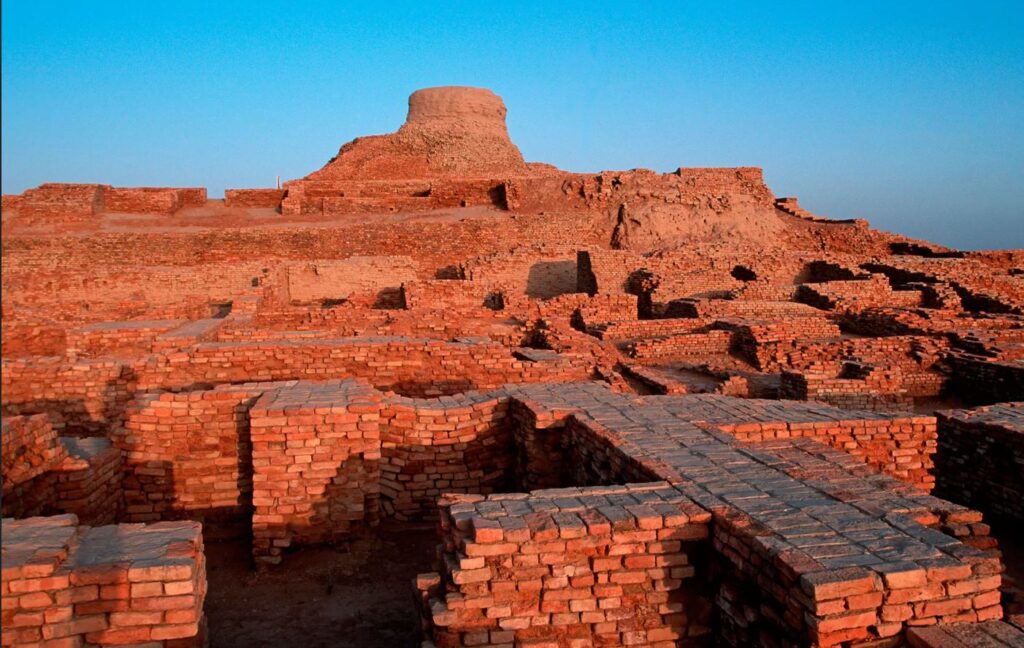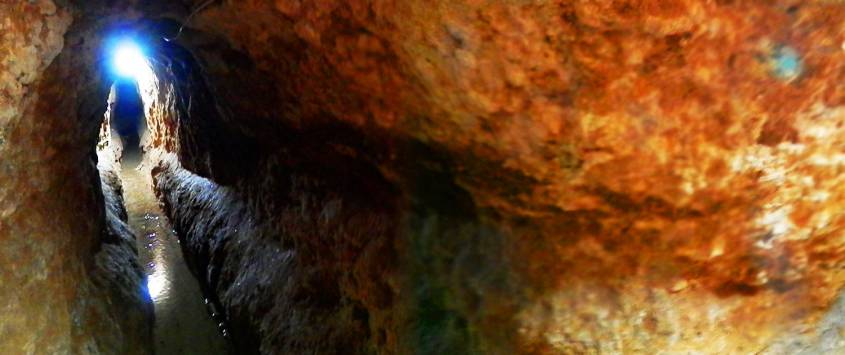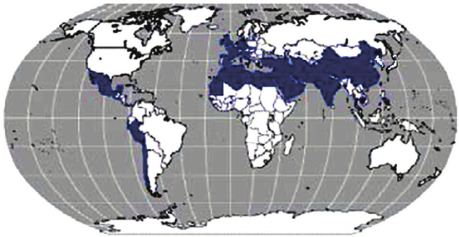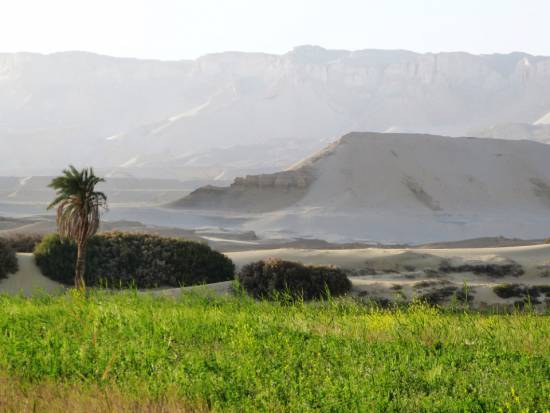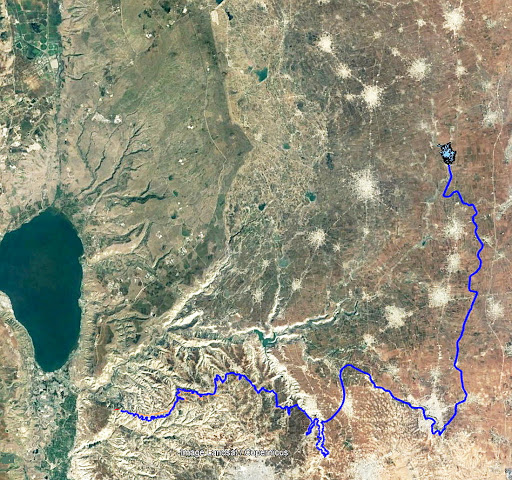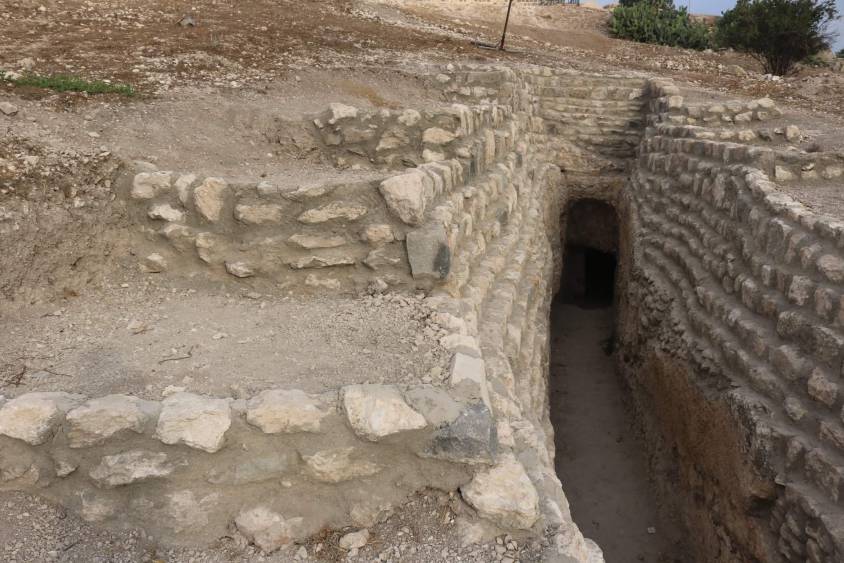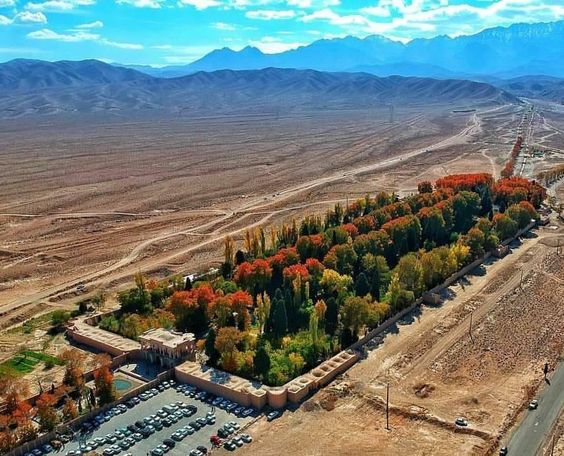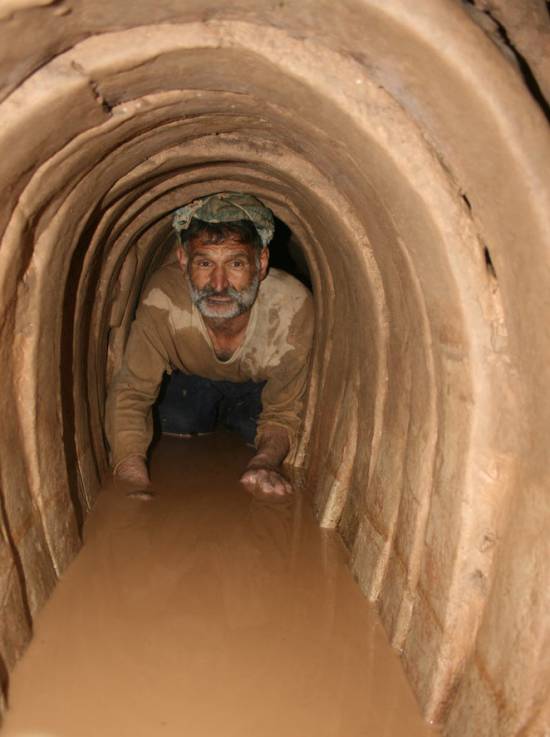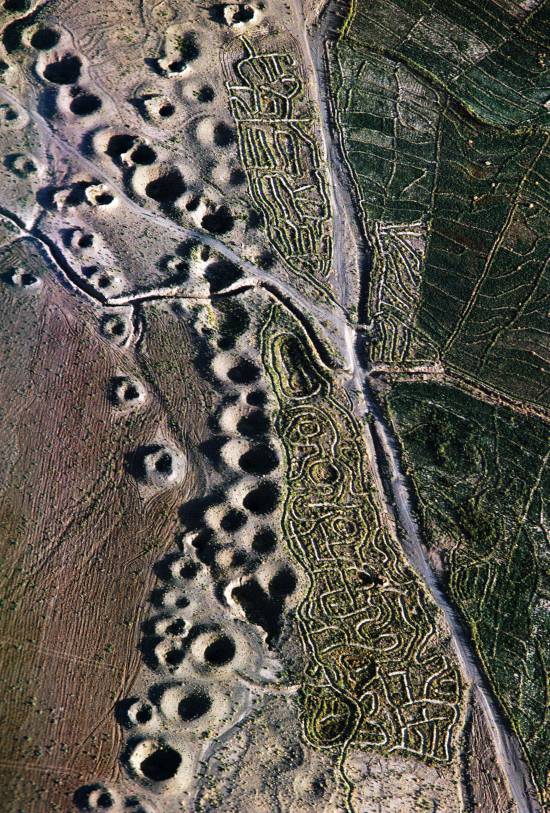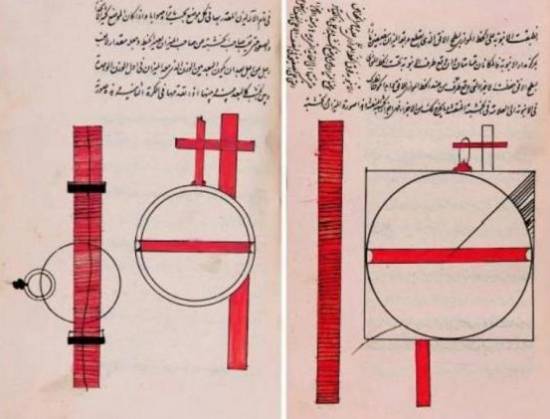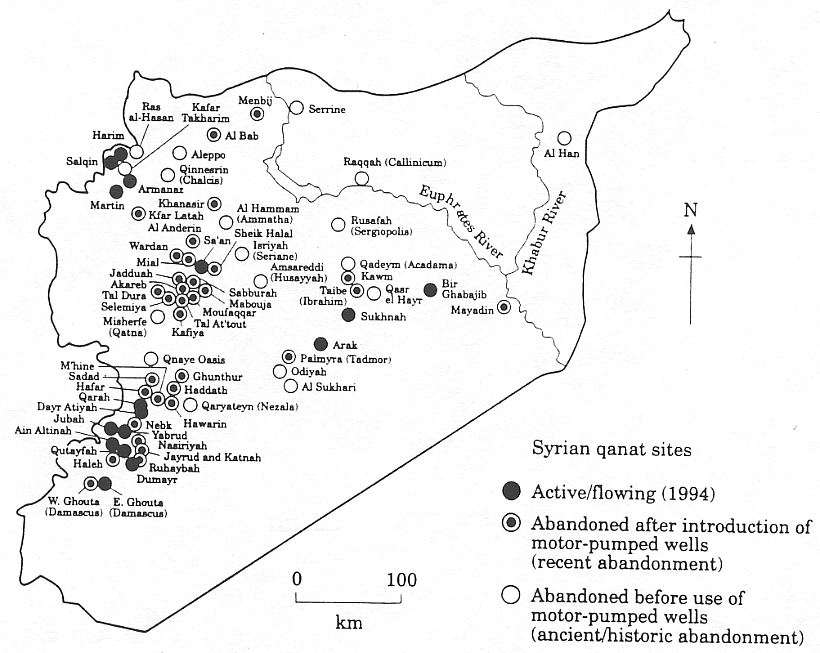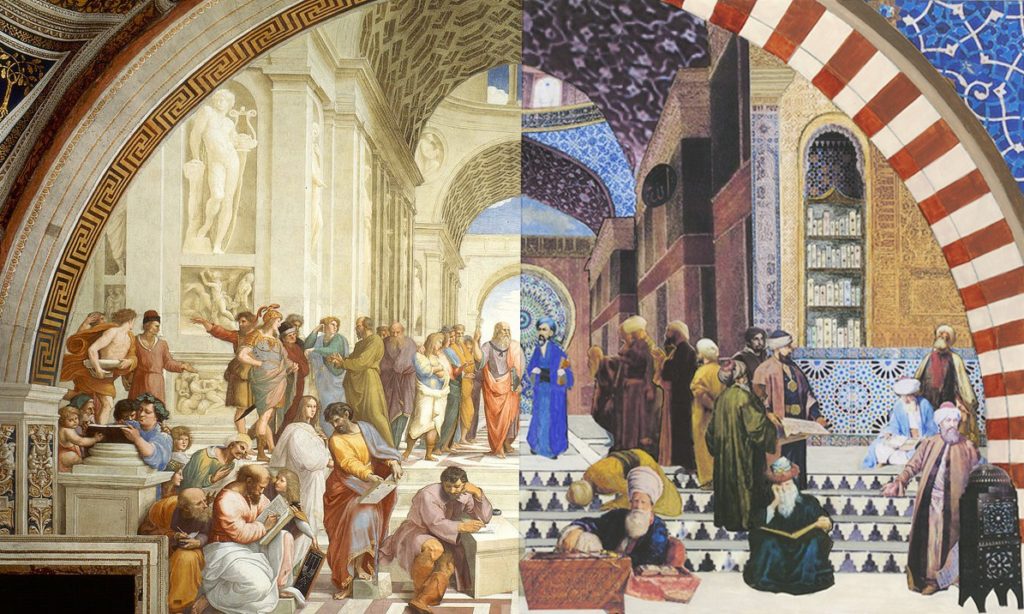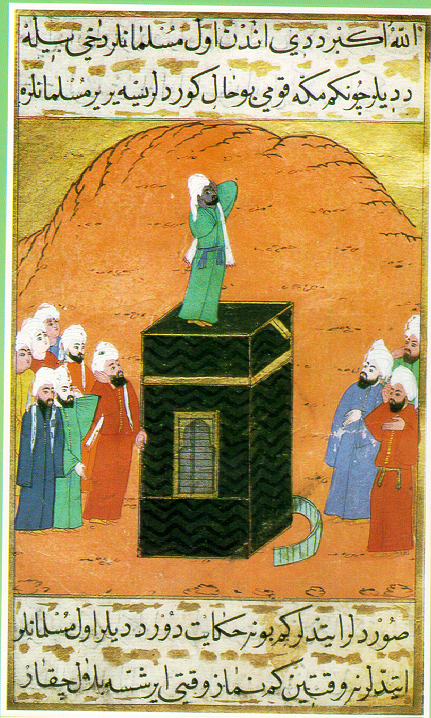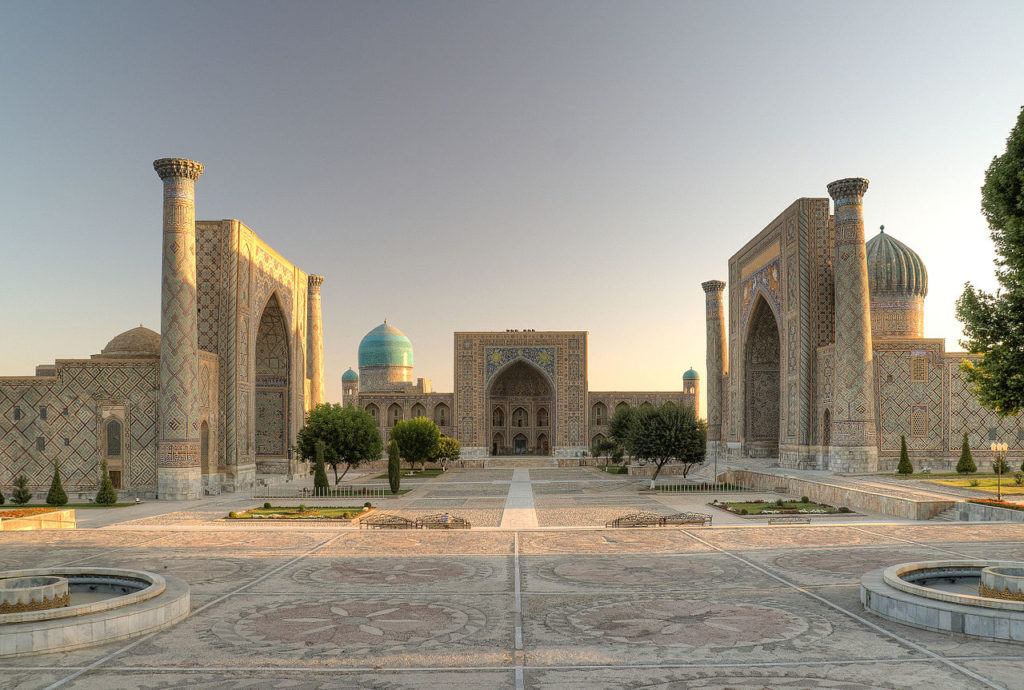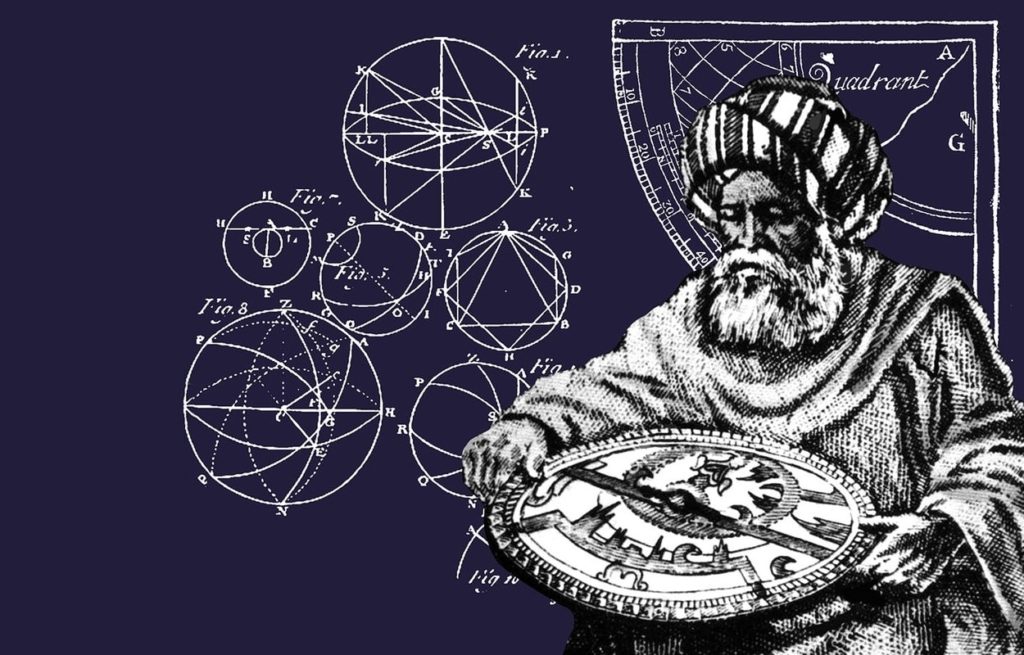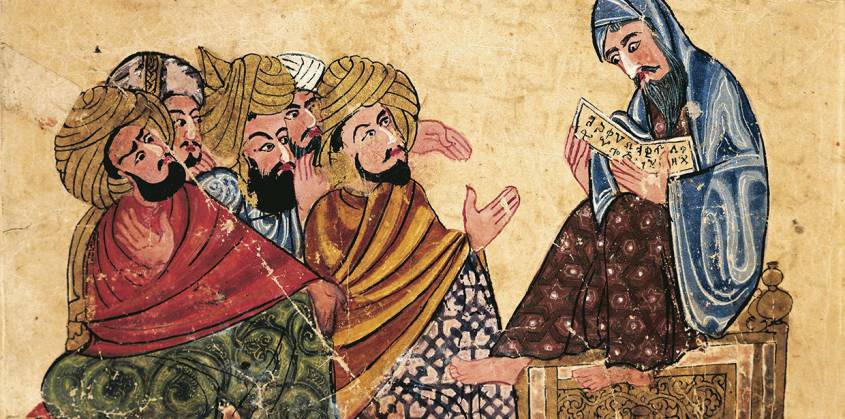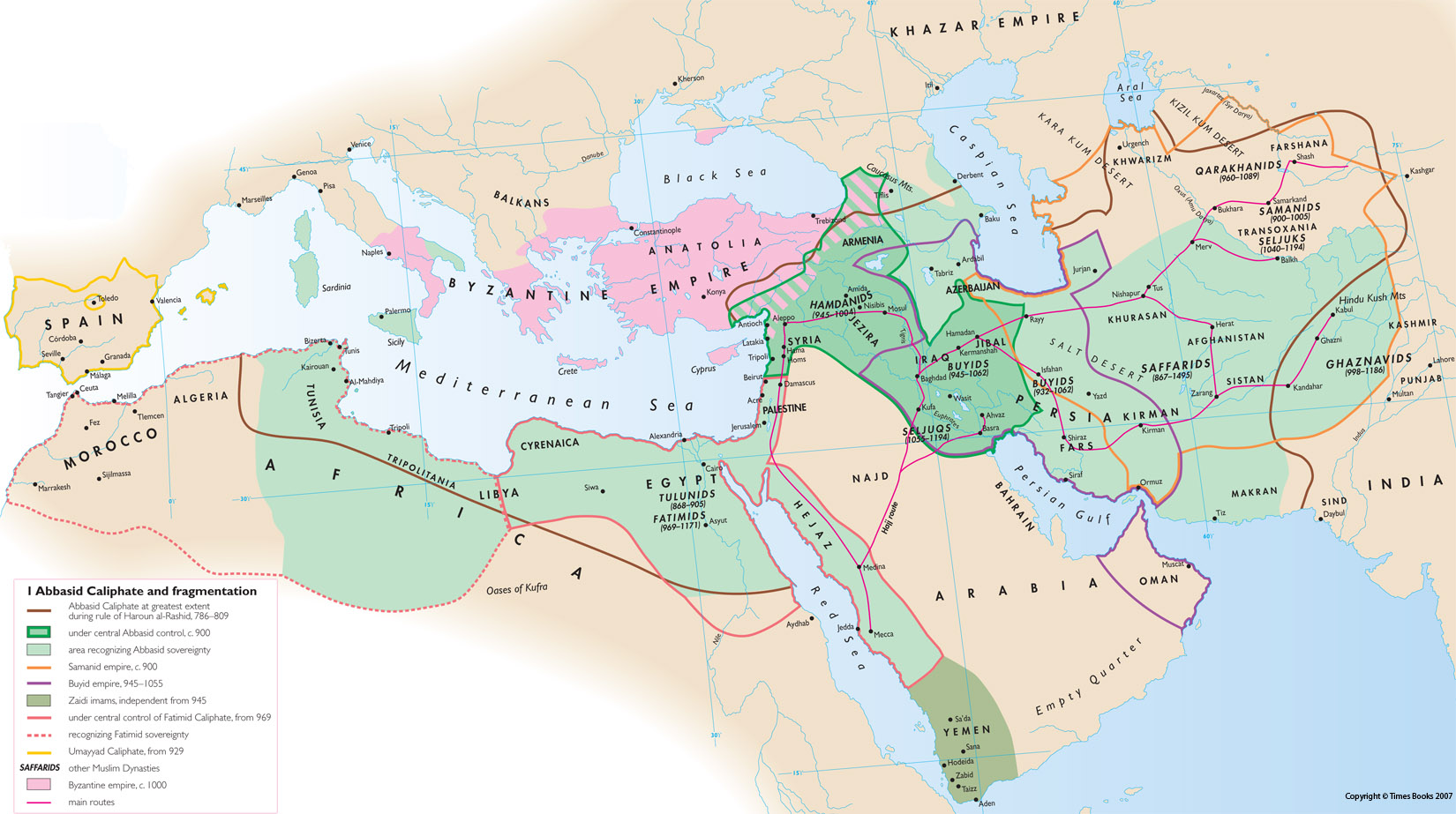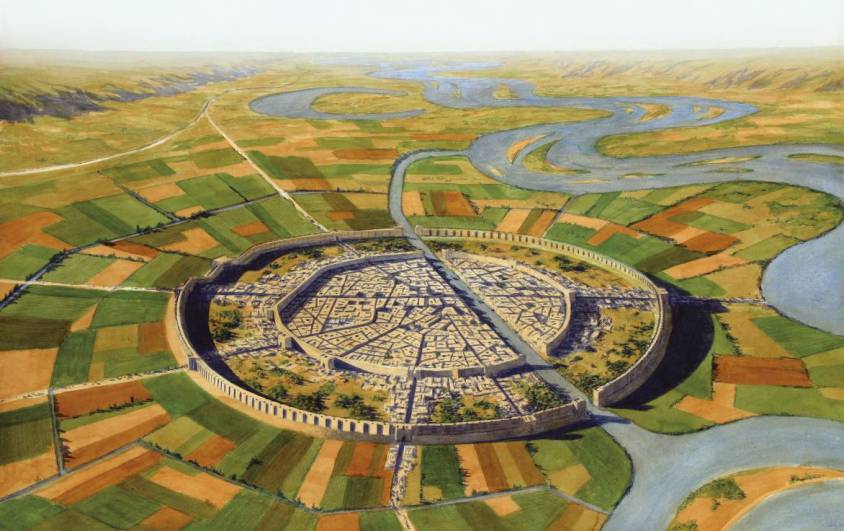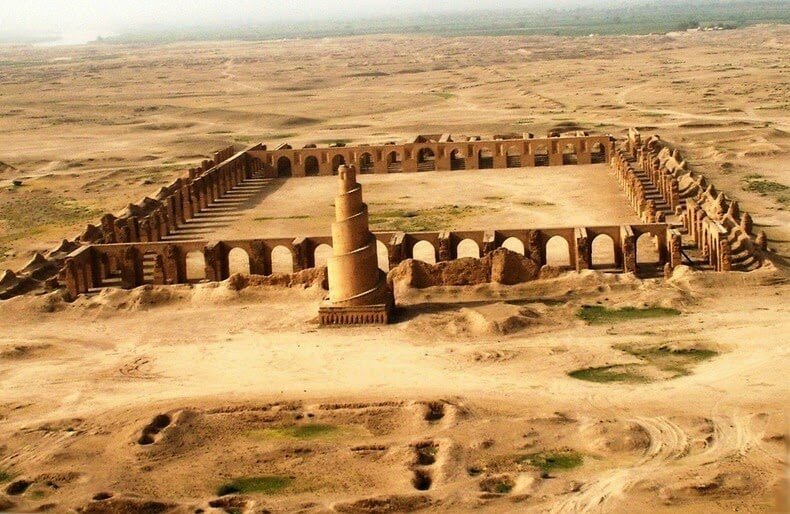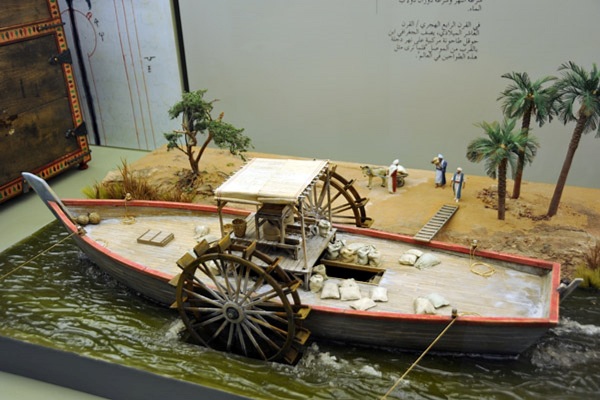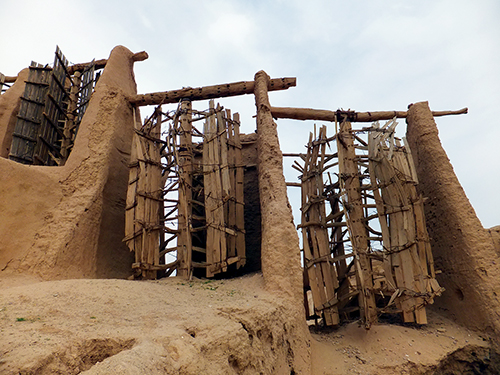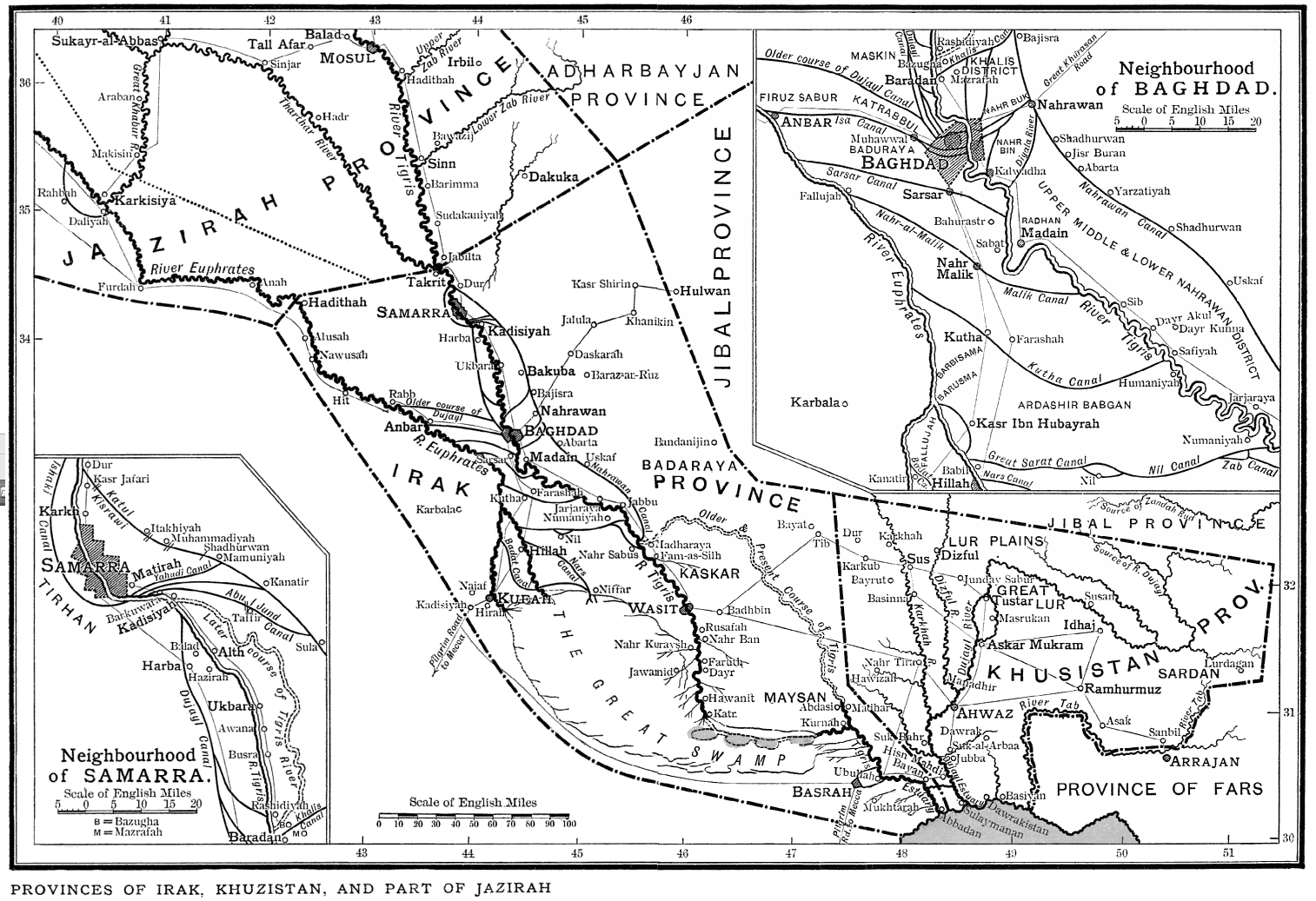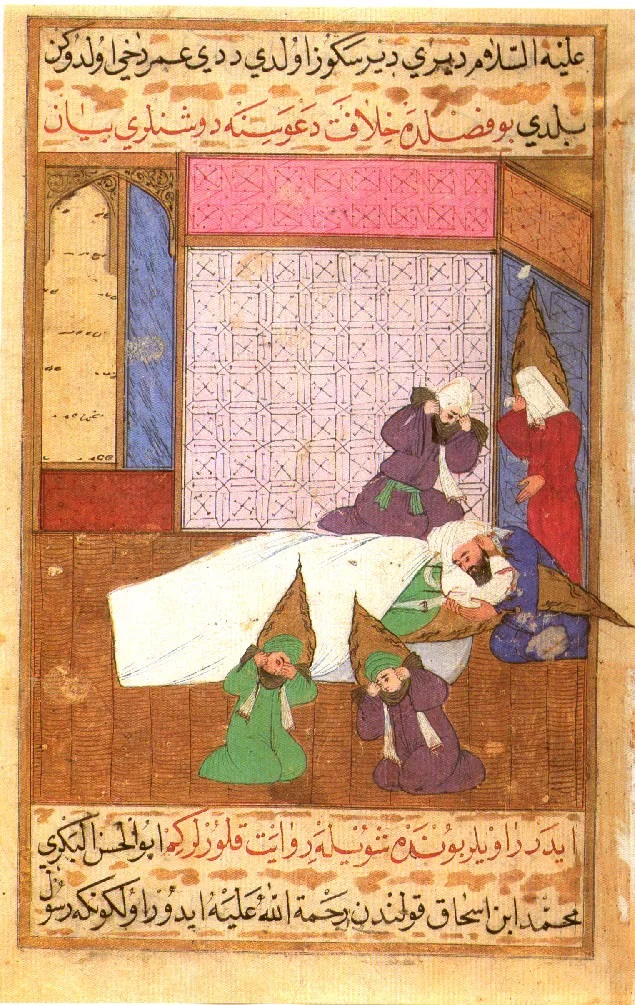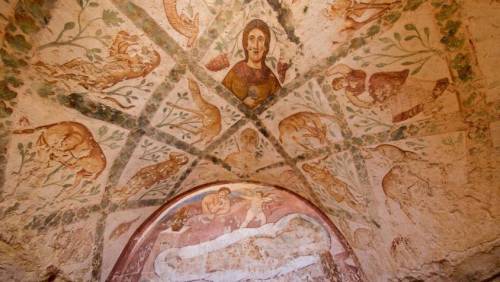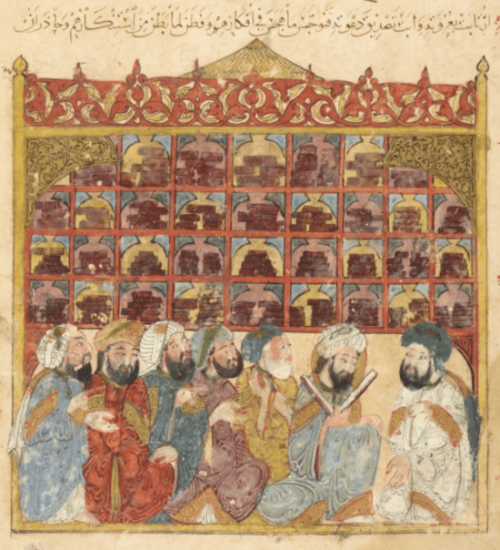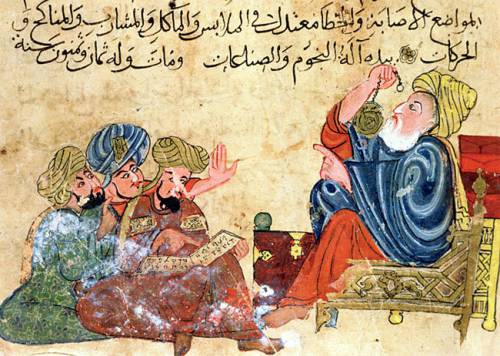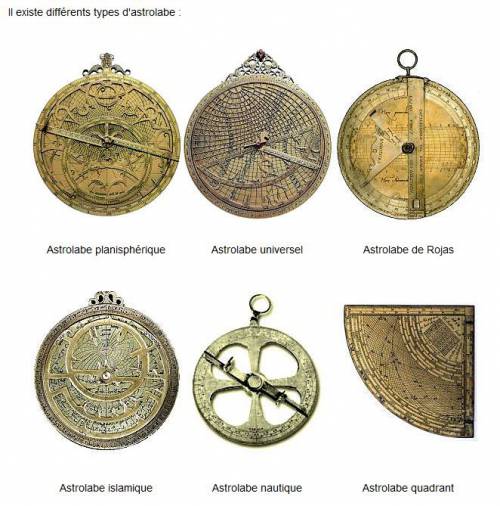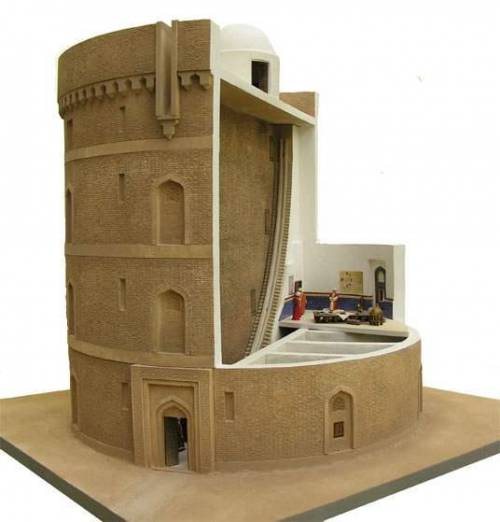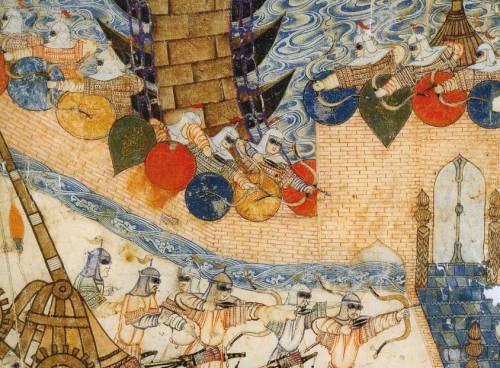Étiquette : China
Thanks to WEST’s new record, world’s nuclear fusion community moving forward


On Monday May 27, 2024, Karel Vereycken talked to physicist and nuclear fusion specialist Alain Bécoulet for Nouvelle Solidarité. He has been in charge of the ITER project’s engineering department since February 2020.
ITER is a large-scale scientific experiment intended to prove the viability of fusion as an energy source. ITER is currently under construction in the south of France. In an unprecedented international effort, seven partners—China, the European Union, India, Japan, Korea, Russia and the United States—have pooled their financial and scientific resources to build the biggest fusion reactor in history.
Alain Bécoulet is a former research director at the French Alternative Energies and Atomic Energy Commission (CEA), and in particular director of the IRFM, the Institut de recherche sur la fusion par confinement magnétique (Institute for Research on Fusion by Magnetic Confinement).
Karel Vereycken: Mr. Bécoulet, good morning, it’s great to have you on the phone.
Alain Bécoulet: Hello Mr. Vereycken, if I’ve understood correctly, you’re interested in what happened at WEST, in connection with the press releases that went out just about everywhere around May 15. (more below)
That’s right; I’ll give you my impressions and you can correct me. I understand that the Tore SUPRA Tokamak (in southern France)1, who with six minutes held a world record in duration till 2021, was a bit like your baby.
To tell the truth, I was director of the IRFM2, in charge of Tore SUPRA. If it can be considered “my baby”, it’s because under my governance it was radically modified and upgraded, and renamed “WEST”. Before me, it was Robert Aymar‘s baby3.

Right! But in WEST, it’s the W that does it all. And it’s a W for tungsten, a very heat resisting material that absorbs less than graphite and makes the machine more efficient?

Yes, it does. The major change we made with WEST, is that we went from a circular-limiter machine 4 to a “divertor” machine.5
On Tore SUPRA, the vertical plasma action was a circle resting on a graphite limiter and the plasma simply touched it.
For some years now, we’ve discovered that making a plasma in the shape of a D, or in the shape of a fish with an X point — called a “divertor” — produces much better results in terms of confining heat and impurities, particles, etc. So it was time for Tore SUPRA to go there.
At the same time, Tore SUPRA itself made it clear for us, that for ITER, it was not possible to continue with carbon – which was ITER’s original intention – and so ITER switched and was reconfigured to tungsten.

That’s when we took the opportunity to install a cooled tungsten divertor in Tore SUPRA. What’s more, Tore SUPRA’s mission has always been, even before ITER – we’ve been talking about it for a very long time now – the development and integration of technological solutions, and not so much performance-fusion.
If you put tritium in Tore SUPRA, you’re not going to get much in the way of power: it’s too small and not powerful enough in any ways to make fusion reactions of any note; but on the other hand, it’s perfectly relevant for all technological developments – it was on Tore SUPRA, it has to be recalled, that the first successful full-scale test of the superconducting coils now used in ITER took place!
I’m fully aware of that.
It was also Tore SUPRA that supplied all the rules for actively cooling all the components in front of the plasma, including diagnostics [i.e. measuring instruments], etc.; not forgetting solutions for continuous additional heating, in short a huge amount of technology.
So the idea, in the transition from Tore SUPRA to WEST, was to continue along the path of the “actively cooled tungsten divertor”.

I think the Koreans, too, with KSTAR, had already.…
There are several superconducting machines that have made equivalent advances –more successive than simultaneous– and that have inspired others; in this case, before talking about KSTAR, the machine that is closest to WEST, its little sister – you’re going to smile, but I didn’t call it WEST for nothing — is a machine that started up when Tore SUPRA was already operating, in Hefei, China, called EAST — with which we have cooperated enormously, both on coils and on plasma components, etc.

So the two laboratories have cooperated enormously; I chose the name WEST because we wanted to change the name of Tore SUPRA, to rejuvenate it and mark the fact that we were making this technology; so we called it WEST, a sort of sister machine to EAST, and the two machines really work together (EAST has now installed a tungsten divertor, etc.). ); even some of the modifications we made to WEST were made in cooperation, in partnership with the EAST machine, with the Chinese Academy of Sciences, which supplied us with components, in particular the power supplies for the divertor coils, the new ICRH antennas, etc.; we had all this done by the Chinese.6
It’s extraordinary that this kind of cooperation can still take place in this world of conflict…
It really is! As for KSTAR, it’s quite a similar machine too, but I’d call it less pioneering. It’s only now arriving in this kind of world; it’s a long way behind –not that I’m blaming them, because since the teams are smaller, it’s more difficult– but that doesn’t stop us from cooperating a lot with KSTAR.
The only real difference with WEST lies in the coils, which are all inside a single cryostat (refrigeration system) – as with ITER, whereas in Tore SUPRA, when we built it, the coils were each in a separate cryostat.
To sum up: today, the large superconducting machines accompanying the ITER project are WEST, EAST, KSTAR and now the new JT60SA tokamak which has just gone into operation in Japan. It’s the size of the JET (at Culham in the UK) in superconductor, but doesn’t yet have a tungsten environment, and won’t for several years yet; so it’s not yet fully in a world as relevant, but it’s coming! And because it’s larger, it’ll probably outperform those EAST, WEST, etc. machines.
The press, and the official press release, reports a 15% gain in energy produced – which is still less than the energy spent on the reaction – and at the same time, they talk of a doubling of plasma density.
Please note: machines like WEST, EAST and KSTAR will never produce power fusion, for at least two good reasons:
- they’re too small;
- they’re not designed to hold tritium.
So there’s no fusion in these machines. Also, beware of energy gains and the like: these are gains in energy stored inside the machine, but not at all in energy supplied, in energy produced by fusion energy.
It’s not yet “break-even” (when the energy produced exceeds that of the reaction).
In fact, we improve confinement and increase confinement time. This improves the possibility of fusion, but we don’t enjoy fusion in these machines, which are too small and not powerful enough for that, particularly in terms of core plasma.
On the other hand, they are used because their edge plasma, i.e. the plasma inside the plasma interacting with structures such as tungsten, etc., is very similar to ITER’s. That’s why they’re so interesting, and as they can produce very long-lasting plasmas, the tests carried out in these machines are perfectly relevant to ITER.
So I’d like to come back to one of your questions, namely how this advances the promises of ITER. ITER is being built, and things are being manufactured, but ITER is a kind of big eater, constantly asking: “Can you continue the research?”

Obviously, we’re into things we’ve never tested, so anything we can test, anything that can debug things for us, is very welcome. So these machines, in particular WEST, EAST, etc., are helping us to consolidate our position, both in terms of design and in terms of manufacturing solutions –a divertor like the tungsten divertor currently cooled, it works!
And what WEST has just demonstrated– compared with the last time, when it achieved very high performance, particularly in terms of duration, with the Tore SUPRA configuration, on a carbon limiter, etc. — it did so in even more relevant conditions, thanks to a tungsten divertor.
The result of WEST was 364 seconds, or 6 minutes and 4 seconds, with an injected energy of 1.15 GJ, a stationary temperature of 50 million°C (4 keV) and an electron density twice that of the discharges obtained in the previous tokamak configuration, that of Tore SUPRA.
However, what’s really new and very important for ITER is that when these machines do this, it’s with components facing the plasma that are the same as ITER’s. We’ve taken great care to ensure that the WEST divertor has exactly the same technology as the ITER divertor. That’s how we test this technology, over timescales and with power flows arriving on these components that are highly relevant, as they are representative of the conditions in which they will live in ITER.

So ITER has become a globalized scientific experiment, decentralized and centralized at the same time.
ITER is the place where all the world’s fusion knowledge is being synthesized; but this process didn’t stop the day we signed the treaty, it’s being synthesized every day!
We continue to feed ITER with scientific and technical results. For example, if a machine says to us “wait a minute, you’ve done that, but we’ve found results that are different now that we’ve done more work”, we look at that very carefully, to find out whether or not there are any impacts. We’re in constant contact with all these people, to find out what’s coming out of the labs, experiments and simulations, and to find out whether or not there’s an impact on ITER, in which case we’re able to rectify the situation according to the scale of things
This sharing of cooperative data takes place in conditions of great trust?
It’s a scientific community that works like a scientific community, with no preconceptions, no ulterior motives, nothing at all.
A bit like the astronauts on the international space station?
Absolutely. We used to say “in the old days, it was taken for granted”, but now it’s true that it’s become almost surprising. If there’s a result in a Russian or Chinese machine, we have access to it and then we understand, we work, we discuss with them, it’s really very open.
That’s very promising.
We have to fight against the journalists who love to wonder whether there’s competition, whether someone has won or whatever…. That’s not what we’re about at all; we’re about cooperative scientific development. Everyone works in their own corner, of course, but for everyone! There’s no such thing as “I know, I know”, no, none of that exists in the world of fusion.
In the article I’m preparing, I’ll conclude by saying that the big problem with ITER is that there’s only one problem!
In a way, it’s almost true, it’s not the “big problem”, but it’s something that doesn’t encourage acceleration; competition encourages acceleration, we agree on that.
After all, the Chinese have 6 fusion reactors…
Be careful, they’re not “reactors”, beware of the vocabulary. They’re experiments, Tokamaks, plasma experiments, all much smaller. The biggest one I mentioned, in Japan, is ten times smaller than ITER!
Now there are start-ups and others, which we’re hosting here (at the CEA center in Cadarache, France) for three days; 50 start-ups are here, downstairs in the amphitheater, chatting with us; they’re all convinced they’re making reactors, but no! They’re just doing experiments, manips, experimental prototypes. Yes, even ITER isn’t a reactor. Mind you, the meaning of the word “reactor” is to produce electricity or energy, and we’re not there yet!
If someone tells you he is selling you a reactor, you can laugh in his face, because it’s not true, and it will remain so for a long time, unfortunately or fortunately, I don’t know. As far as the reactor phase is concerned, we’ve only just begun, with ITER, the transition to industry. That’s what we’re also doing these days, looking at how to transfer knowledge from laboratories – and ITER is THE world laboratory, in the true sense of the word, in the sense of a public research laboratory. How do we begin to transfer this to the industrialists who will have to build the reactors? But the time scale here isn’t next week!
Wouldn’t your real competitor be the National Ignition Facility (NIF)?7
Not even close! Because with the Americans, it’s in a way even worse, because they’re even less developed in their public research, it’s a long way from maturity. They once did a demonstration in a machine that wasn’t designed for it, and so on.
So if we wanted to go from the NIF to the reactor, we’d already have to make up all the ground we’ve accumulated since the state of magnetic fusion with the big JET experiments in 1997. So we’re almost 30 years away from reaching the levels of technological maturity, integration and overall maturity needed to move towards a reactor. And we, too, are still a long way from moving towards the reactor.
As far as competitors are concerned, to be honest, no one feels like a competitor today, and this is no joke: may the best man win! The problem is so complicated, and the stakes so high, that whoever comes up with the solution will have us all on our feet! There’s no such thing as competition.
We’re starting to see, with these new start-ups, people saying “yes, but we’re moving towards industrial solutions, etc., so we may develop patents that we obviously don’t want to reveal or sell”. Fair enough!
But hey, if they know how to make one of the “technological bricks” and it has a patent, good for them. But that’s not even going to stop us talking. A patent, once you’ve registered it, isn’t a secret, it’s simply something that belongs to you and that you can put on the public square; whoever uses it is just going to have to pay for it, that’s all. So it’s not a war or anything.
The problem is really extremely complicated, and we’re now entering the pre-industrial world of the thing, which is very exciting, isn’t it! I started my career as a theoretician 35 years ago, and I can tell you that we were really on the calculator and not even on the computer yet. Now we’re in: 1/ a complete demonstration of the feasibility of the whole system with ITER, which is in a way the end (the objective) of fundamental public research; 2/ the moment when we’ll say “here’s the great recipe, now it’s up to you to industrialize it, improve it, make it economically viable, etc.”. But ITER still has to show that we can do it, and I believe we can, even though we’re still building the machine and haven’t yet made plasma! But then again, on paper it’s always beautiful…
What do you see as the final hurdles? What more can the public authorities in the various countries do?
I’d encourage you to keep an eye on things until October-November, when the International Atomic Energy Agency (IAEA) will issue a strategic document, prepared by all of us –and I’m one of its key authors. It’s a global strategy document on the development of fusion energy, i.e. the production of energy through fusion.
It’s a very interesting document which, in around twenty pages, covers all the regulatory, technological, scientific and industrial aspects – everything you could possibly dream of: it’s got it all!
And it gives a great deal of information on the challenges facing this community – which is in the process of moving from a purely public research community to a mixed public-private community, moving towards industry, etc. – and on what remains to be done by this community, in terms of nuclear regulations, industrialization, work on the overall efficiency of all sub-systems, and availability (a reactor can’t just run for three minutes every day, it has to work 24 hours a day for 40 years).
This strategic document, which will be issued by the International Agency, should enable all players – I’d almost say “outsiders”: investors, the press, politicians, etc. – to understand where the merger stands and what remains to be done. So it’s a fairly ambitious document, with such a lofty goal, but one that has been made simple and readable for once; we’ve put a lot of effort into it, and I think we’ve succeeded.
It’s really condensed: each paragraph covers 40 or 50 years of research (!), but I think it’s understandable; at the moment it’s being edited by the IAEA, and will be published in early autumn.
Ok, we’ll watch that.
And finally, here are my thoughts on what remains to be done for fusion:
- New technological building blocks. There are things that even ITER won’t be able to do, such as fully demonstrating the closure of the tritium cycle – how to make tritium, and how to really burn it in situ; we’re going to do a few demonstrations, but we don’t yet have the complete cycle, and we won’t have it just with ITER.
- Materials. Since magnetic fusion generates very energetic neutrons, and lots of them – a machine like ITER is designed to live for a certain time with a certain plasma rhythm, so it has no problem surviving these neutrons. But if we built the same ITER and ran it for 40 years, 24 hours a day, it wouldn’t last; its materials wouldn’t stand up to the shock. So we need other materials, and materials research and development.
- This brings us to maintenance: how can we learn to intervene in these kinds of objects without disturbing them too much, working with robotics and appropriate intelligence to understand these extremely complex systems? So we also need to model them; some elements are very difficult to manufacture, so we need to think about how to work on the design so that manufacturers have less difficulty in doing what they’re asked to do, etc.
- There are also nuclear regulations.
Is this new measuring device just demonstrated on WEST really a breakthrough?
The first to communicate this WEST result were the Americans, which surprised me, but hey, why not?
Yes, it surprised me too.
Because of an unfortunate sentence at the beginning of their article, we got the impression that WEST was a machine from the Princeton laboratory!
Yes, that’s right!
International Cooperation
I spoke to you about the collaboration with China; when I created WEST, we set up a collaborative, partnership-based process that is almost even more ambitious than ITER. We partnered some thirty laboratories around the world to help us build WEST. It thus became a kind of international machine, operated by the CEA without any problems, but an international machine, and we played the same role as ITER: we tried to do what we call supply in kind –I mentioned the Chinese, who gave us power supplies, heating antennas, etc., but there are many countries like that: the Indians have manufactured and supplied us with things, and in this case the Princeton laboratory has designed, manufactured and installed a diagnostic: what you call a measuring instrument is in fact an advance that we test on the machine, and the Americans, or the Princeton people now, can now say “there, we know how to do that, and the proof: we tested it there and there, etc.”. You can think of these major research instruments (like WEST, EAST, etc.), particularly in the field of fusion, as test benches for all kinds of things.
Do we have a machine that actually makes plasma? It’s a bit like CERN (Geneva based particle accellerator), where you’ve got a device that accelerates particles, and then you’ve got lots of people who come to watch, put particles together, make them collide like this, put them in this detector, make them do something, and exploit the science that goes with it.
A Tokamak is also a test bench somewhere, for testing components with plasma, diagnostics, heating systems and so on. So it lends itself well to partnership, because you’ve got a central unit, a central operator who’s going to do the bulk of the machine, who’s going to rectify the coils or the enclosures, etc.; and then afterwards, you can have a huge number of people who are going to come and contribute to a brick that we’re going to put into this machine.
And WEST works with China, with Korea, with many French laboratories –CNRS laboratories and universities that simply bring us diagnostics or simulations – with the United States, with India and with many other countries. And we have a steering committee; for this machine, it’s not just the CEA that decides on its experimental plan: once a year, people from all these labs get together to examine what we’ve done and what we want to do with this machine. Remember that these are always integrated contributions, mixing technology and physics.
It’s wonderful! Thank you for your answers, which have shown us the global, shared process towards a more peaceful world.
We’re trying… We believe in scientific diplomacy here. It’s not easy, it’s no easier than normal diplomacy, but scientific diplomacy does exist, it’s an aspect we believe in and demonstrate every day, we show that it exists and that it also contributes, effectively, to the planet’s progress, even if sometimes it’s more difficult… I’m used to comparing it to sports or artistic diplomacy; the Olympic Games shouldn’t turn as sour as it’s turning, it doesn’t make sense.
Thank you, congratulations, we’re proud of you and your teams, keep up the good work!
Thank you very much. See you soon.
- With a major radius of 2.25m (machine centre to plasma centre) and a minor radius of 0,70m, Tore Supra (before it was reconfigured as WEST) was one of the largest tokamaks in the world. Its main feature was the superconducting toroidal magnets which enabled generation of a permanent toroidal magnetic field. Tore Supra was also the only tokamak with plasma facing components actively cooled. Theses two features allow the study of plasma with long pulse duration. ↩︎
- Institut de recherche sur la fusion par confinement magnétique (Institute for Research on Fusion by Magnetic Confinement. ↩︎
- Robert Aymar was the Director General of CERN (2004–2008), serving a five-year term in that role. In 1977, Robert Aymar was appointed Head of the Tore Supra Project, to be constructed at Cadarache (France). In 1990, he was appointed Director of the Direction des Sciences de la Matière of the CEA, where he directed a wide range of basic research programmes, both experimental and theoretical. ↩︎
- The “Limiter” of the Tore SUPRA tokamak (made of graphite), was the element that extracted most of the energy contained in the plasma (in the shape of a flat circular ring located in the lower part of the donut shaped machine).
↩︎ - In WEST, the actively cooled 456-component divertor at the bottom of the vacuum vessel extracts the heat and ash produced by the fusion reaction, minimizes plasma contamination and protects the surrounding walls from thermal and neutron loads. ↩︎
- Most of this industrial production (i.e. 16,000 blocks of tungsten), was carried out by AT&M (China), with the support of the Chinese laboratory ASIPP as part of the joint CEA-China collaboration (SIFFER, SIno French Fusion Energy centeR). Already, in 2016, the Institute of Plasma Physics (ASIPP) of the Chinese Academy of Sciences (CAS), had supplied ICRH (Ion Cyclotron Resonant Heating) antennas for Tore SUPRA. ↩︎
- In December 2022, an NIF experiment used 2.05 megajoules of laser energy to produce 3.15 megajoules of fusion energy.
↩︎
LOUVRE AUDIO GUIDE: Mona Lisa made in China?


Listen?
Audio on this website
Read?
- La Cène de Léonard, une leçon de métaphysique (FR en ligne) + EN pdf (Fidelio).
- Léonard de Vinci : peintre de mouvement (FR en ligne) + EN pdf (Fidelio).
- La Vierge aux rochers, l’erreur fantastique de Léonard (FR en ligne).
- Romorantin et Léonard ou l’invention de la ville moderne (FR en ligne) + EN pdf (Executive Intelligence Review) + DE pdf (Neue Solidarität) + IT pdf (Movisol website).
- L’Homme de Vitruve de Léonard de Vinci (FR en ligne) + EN online.
- Léonard en résonance avec la peinture traditionnelle chinoise — entretien avec Le Quotidien du Peuple. (en ligne: texte chinois suivi des traductions FR + EN).
Horse-power, the Earthly Science behind China’s “Heavenly Horses”
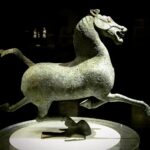
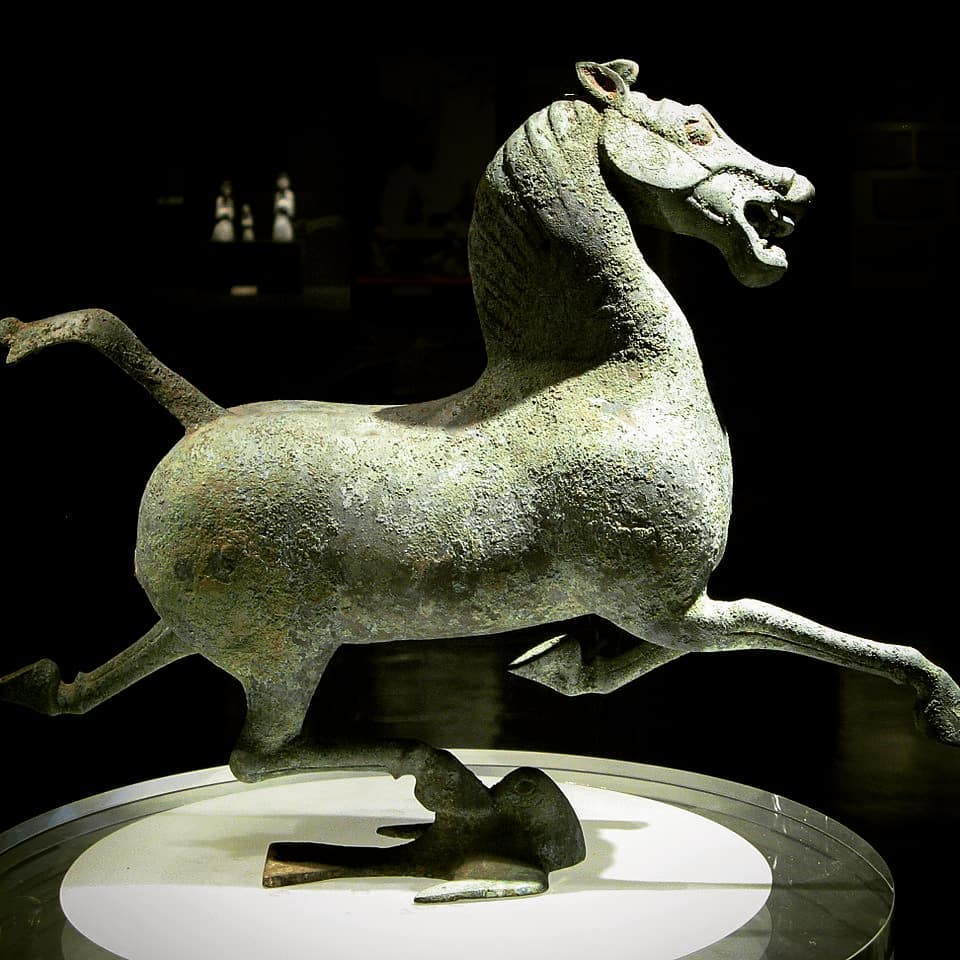
Indicating the major role horses have played in the history of mankind, the fact that still today, when people talk about the engine of their cars, they use the term “horsepower” (hp) to indicate how much “work” the engine is capable of.
In a lecture on hydro-infrastructure in Kabul, Afghanistan, I recently used the domestication of the horse as an example of what one should understand when we talk about moving from a “lower” to a “higher infrastructure platform”.
The history of mankind completely changed with the domestication of the horse. Things considered “impossible” before the domestication of the horse became the “new normal”. How and when horses became domesticated has been disputed. Although horses appear in Paleolithic cave art as early as 36,000 BC (Chauvet cave, France), these were wild horses and were probably hunted for meat.

Zoologists define « domestication » as human control over breeding, which can be detected in ancient skeletal samples by changes in the size and variability of ancient horse populations. Other researchers look at the broader evidence, including skeletal and dental evidence of working activity; weapons, art, and spiritual artifacts; and lifestyle patterns of human cultures. There is evidence that horses were kept as a source of meat and milk before they were trained as working animals.
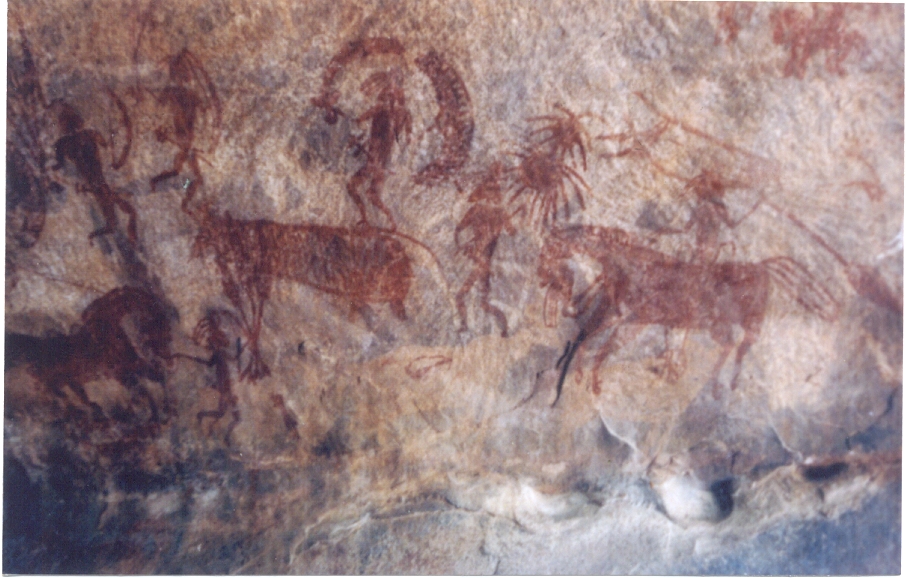
In India, close to Bopal, the “Bhimbetka rock shelters”, which are the oldest known rock art of the country, figures dance and hunting scenes from the Stone Age as well as of warriors on horseback from a later time (10 000 BC).
Horses were a late addition to the barnyard. Dogs were domesticated 15,000 years ago; sheep, pigs and cattle, about 8,000 to 11,000 years ago. But clear evidence of horse domestication doesn’t appear in the archaeological record until about 5,500 years ago.

The clearest evidence of early use of the horse as a means of transport is from chariot burials. The earliest true chariots known are from around 2,000 BC, in burials of the Sintashta-Petrovka culture in modern Russia in a cluster along the upper Tobol river, southeast of Magnitogorsk.
They contain spoke-wheeled chariots drawn by teams of two horses.
Kazakhstan and Ukraine

Up till recently, it was thought that the most common horse used today was a descendant of the horses domesticated by the Botai culture living in the steppes of the Akmola Province of Kazakhstan, around 3500 BC.
Recent genetic research points to the fact that the Botai horses were the forefathers of the Przewalski horse, a species that nearly disappeared.
Our common horse, the Equus ferus caballus, genetic research says, has been domesticated 4,200 years ago in Ukraine, in an area known as the Volga-Don, in the Pontic-Caspian steppe region of Western Eurasia, around 2,200 BC.
As these horses were domesticated, they were regularly interbred with wild horses.

Interesting in this respect, is the fact that according to the “Kurgan” or “steppe hypothesis”, most Indo-European languages spread from the same region throughout Europe and parts of Asia.
It postulates that the people of a Kurgan culture in the Pontic steppe north of the Black Sea were the most likely speakers of what some call the Proto-Indo-European language (PIE).
The term is derived from the Turkic word kurgan, meaning tumulus or burial mound.
Tea Road, Horse Road or Silk Road?
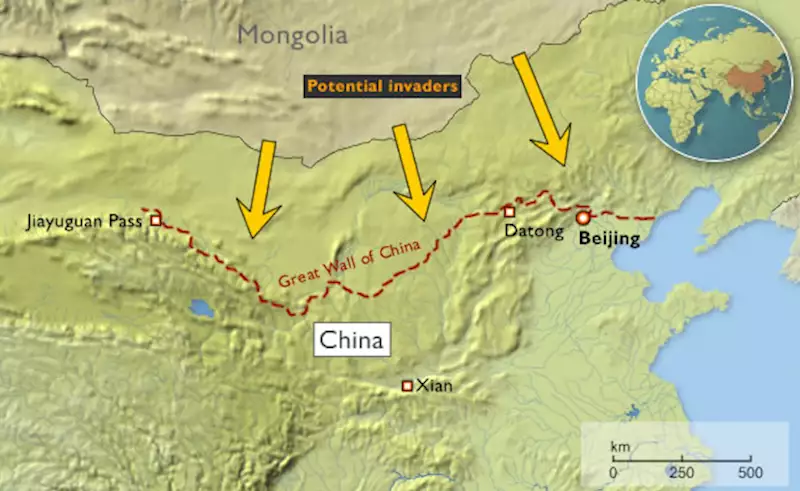

As a matter of fact, the main commodities traded on the “Silk Road” (a term only coined in 1877 by the German geographer Ferdinand Von Richthofen), were… horses, mules, camels, donkeys and onagers.
Silk and tea were of course traded, but appeared mainly as a means… to pay for horses. People “paid” with silk, gold, porcelain and tea, the animals they needed to secure the survival of their society!
What was known as the « Tea-Horse Road » (Southern Silk Road) extended from the city of Chengdu in Sichuan Province, China, south through Yunnan into India and the Indochina Peninsula, and extended westwards into Tibet. It was an important route for the tea trade throughout South China and Southeast Asia and contributed to the spread of religions like Taoism and Buddhism across the region.
Eurasian Steppe
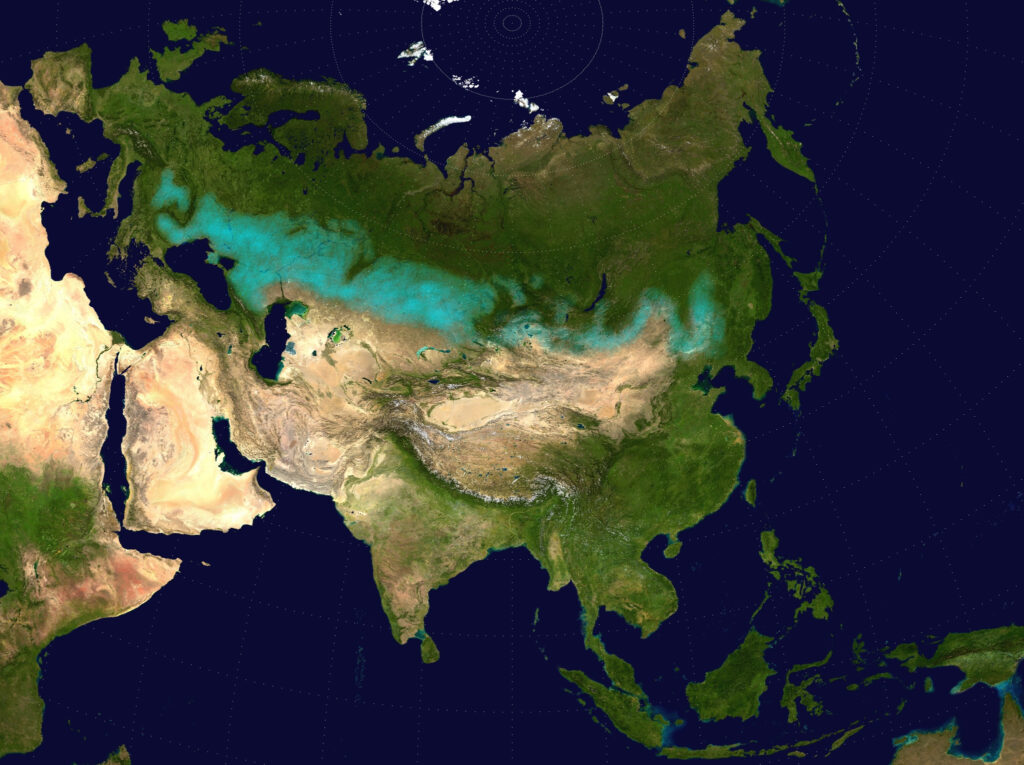
China, feeling itself under constant threat from the nomadic steppe people from the North, started building the first parts of its “Great Wall” as early as the VIIth Century BC, with selective stretches joined by Qin Shi Huang (220–206 BC), the first emperor of China and completed under the Ming dynasty (1368–1644) to become one of the most impressive feats in history.
The Eurasian nomads were groups of nomadic peoples living throughout the Eurasian Steppe. The generic title encompasses the varied ethnic groups who have at times inhabited the steppes of Kazakhstan, Kyrgyzstan, Tajikistan, Turkmenistan, Uzbekistan, Mongolia, Russia, and Ukraine.
By the domestication of the horse around 2,200 BC (i.e. 4,200 years ago), they vastly increased the possibilities of nomadic life and subsequently their economy and culture emphasized horse breeding, horse riding, and nomadic pastoralism, usually engaging in trade with settled peoples around the steppe edges, be it in Europe, Asia or Central Asia.

Nomads, by definition, don’t create empires. It is thought they operated often as confederations. But it was them who developed the chariot, wagon, cavalry, and horseback archery and introduced innovations such as the bridle, bit, stirrup, and saddle and the very rapid rate at which innovations crossed the steppe-lands spread these widely, to be copied by settled peoples bordering the steppes.
During the Iron Age, Scythian (Persian) culture emerged among the Eurasian nomads, which was characterized by a distinct Scythian art.
China and the Horse
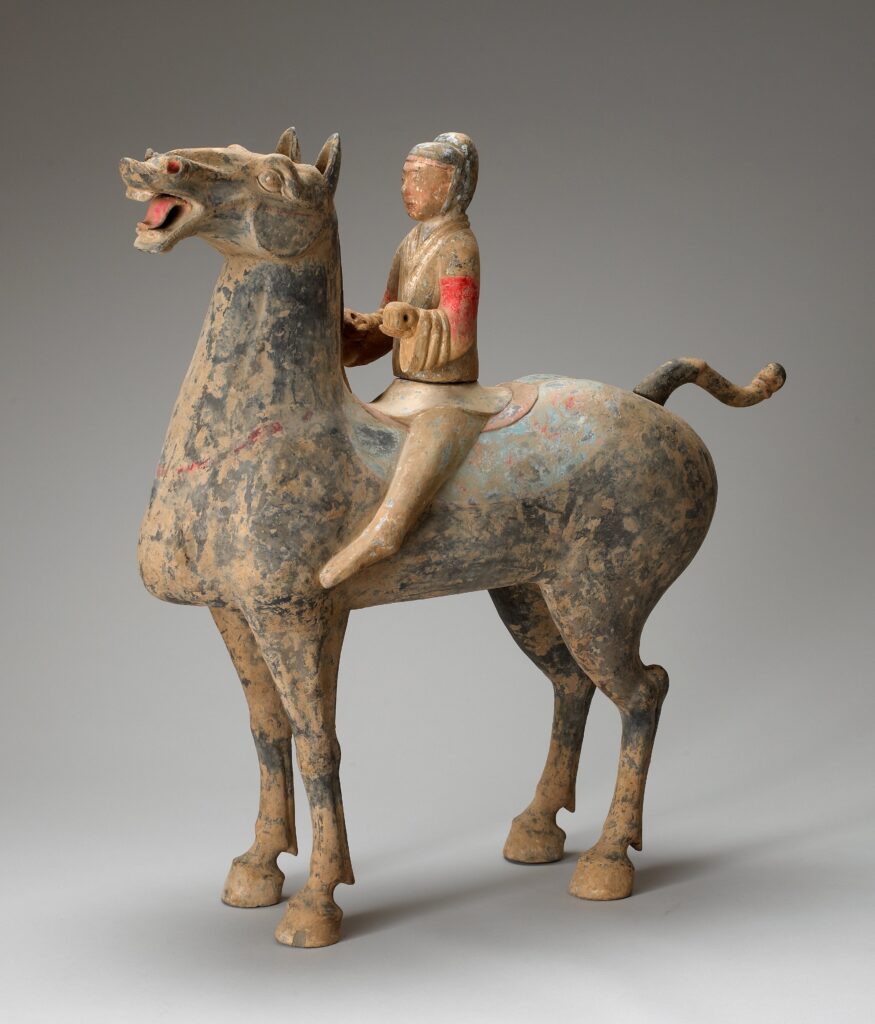
Throughout China’s long and storied past, no animal has impacted its history as greatly as the horse. Its significance was such that as early as the Shang dynasty (ca.1600-1100 BC), military might was measured by the number of the war chariots available to a particular kingdom.
The mounted cavalery, which emerged in the IIIrd century BC grew rapidly during the IInd century BC to meet the challenge of horse-riding peoples threatening China along the northern frontier.
Their large, powerful, horses were very new to China. As said before, traded for luxurious silk, they were the first major import to China from the “Silk Road.”
Chinese grave goods provide extraordinary amounts of information about how the ancient Chinese lived. Archaeological evidence shows that within a few years, the marvelous Arabian steeds had become immensely popular with military and aristocracy alike and upper-class tombs began to be filled with images of these great horses for use in the afterlife. But horses were hard to find in China.
Chinese diplomats and the Kingdom of Dayuan (Ferghana)
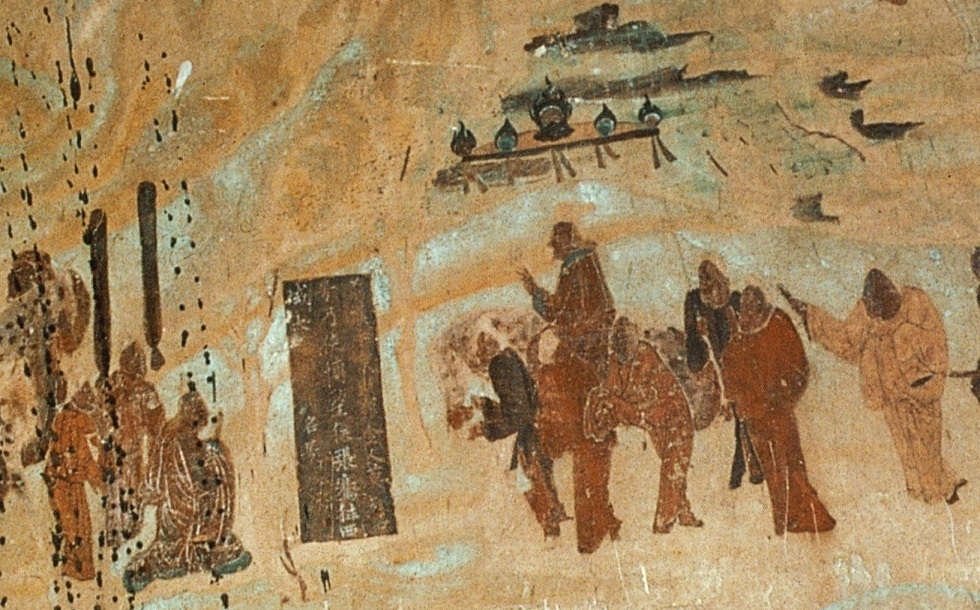
Something had to be done. In the late IInd Century BC, Zhang Qian, a Han dynasty diplomat and explorer, travels to Central Asia and discovers three sophisticated urban civilizations created by Greek settlers he named « Ionians ». The account of his visit to Bactria, including his recollection of his amazement at finding Chinese goods in the markets (acquired via India), as well as his travels to Parthia and Ferghana, are preserved in the works of the early Han historian Sima Qian.

Upon returning to China, his account prompts the Emperor to dispatch Chinese envoys across Central Asia to negotiate and encourage trade with China. Some historians say that this dicision gave « birth of the Silk Road.«
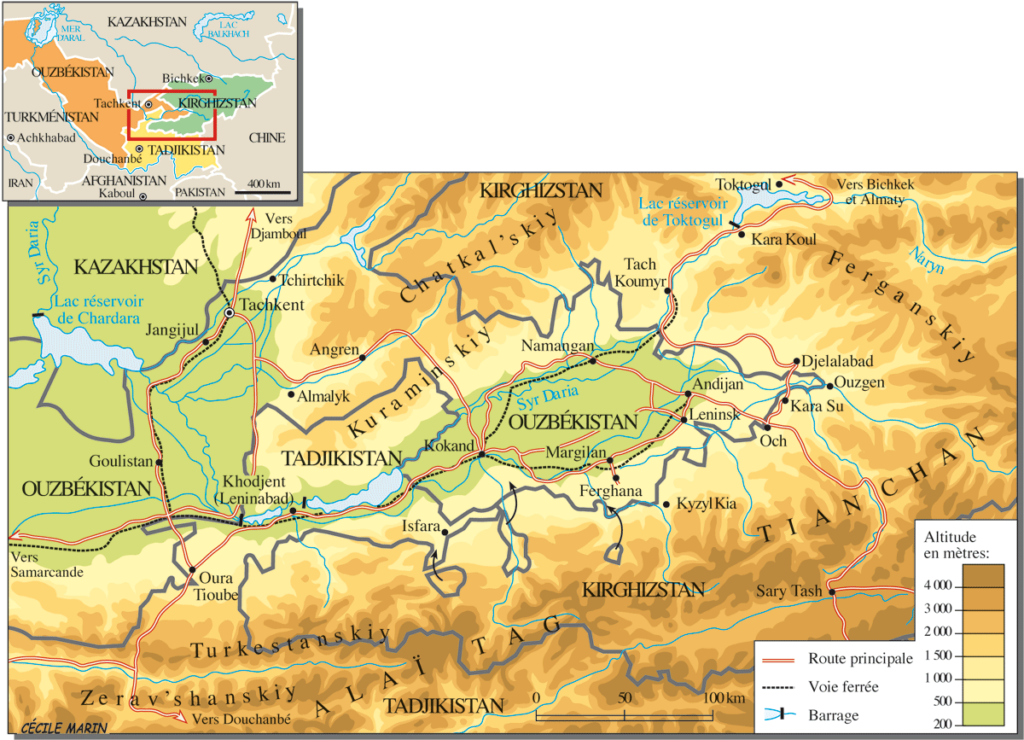
Besides Parthia and Bactria, where Chinese goods were being traded via Indian imports, Zhang Qian visited, in the fertile Ferghana valley (today essentially in Tajikistan), a State the Chinese called the “Kingdom of Dayuan” (“Da” meaning “great”, and “Yuan” being the transliteration of Sanskrit Yavana or Pali Yona, used throughout antiquity in Asia to designate « Ionians », i.e. Greek settlers).
The Records of the Grand Historian and the Book of Han describe the Dayuan as numbering several hundred thousand people living in 70 walled cities of varying size. They grew rice and wheat, and made wine from grapes. They had Caucasian features and “customs identical to those of Bactria” (the most Hellenistic state of the region since Alexander the Great) which is today’s northern Afghanistan.
The Chinese diplomat reported something of great strategic interest: unbelievable, fast and powerful horses raised by these Ionians in the Ferghana Valley!
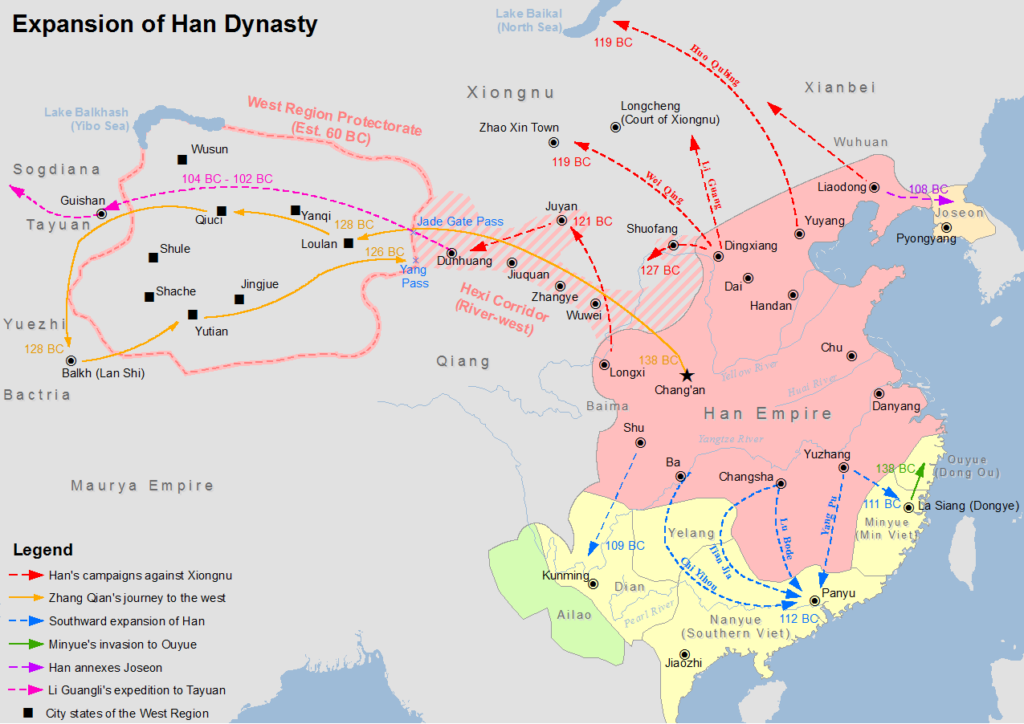
Now, as said before, China felt under permanent threat by the nomadic people from the steppes and was in the process of building the “Great Wall”. China also was acutely aware that the nomadic steppe people derived their military superiority from something dramatically lacking at home: powerful horses !
Added to that, the fact that in terms of China’s scale of values, horses where nearly of the same mythological nature as dragons: they could fly and represented the divine, creative spirit of the universe itself, something essential for any Chinese emperor eager to acquire both military security for his Empire and for his personal immortality.
In short, having good horses became an issue of national security. So much, that in 100 BC, the Han dynasty started what is known as the “War of the Heavenly Horses” with Dayuan, when its ruler refused to provide high quality horses to China !
The War of the Heavenly Horses
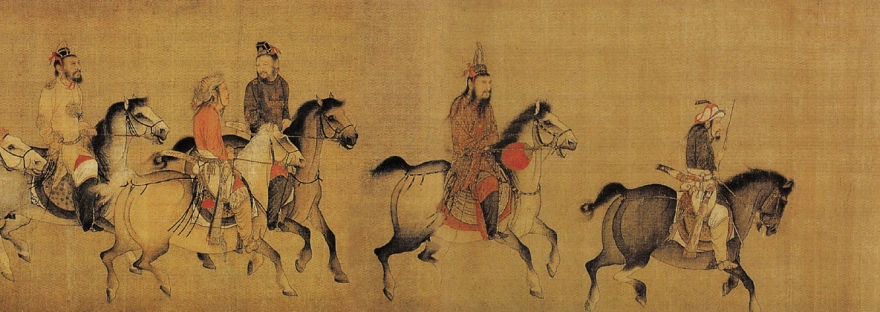
The War of the Heavenly Horses was a military conflict fought in 104 BC and 102 BC between China and a part of the Saka-ruled (Scythian) Greco-Bactrian kingdom known to the Chinese as Dayuan, in the Ferghana Valley (between modern-day Uzbekistan, Kyrgyzstan and Tajikistan).
First, Emperor Wu decided to defeat the nomadic steppe Xiongnu, who had harassed the Han dynasty for decades.
As said earlier, in 139 BC, the emperor sent diplomat Zhang Qian to survey the west and forge a military alliance with the Yuezhi nomads against another group of nomads, the Xiongnu. On the way to Central Asia through the Gobi desert, Zhang was captured twice. On his return, he impressed the emperor with his description of the « Heavenly Horses » of Dayuan, that could greatly improve the quality of Han cavalry mounts when fighting the Xiongnu.
The Han court sent at least five or six, and perhaps as many as ten diplomatic groups annually to Central Asia during this period to get a hold on these “Heavenly Horses”.
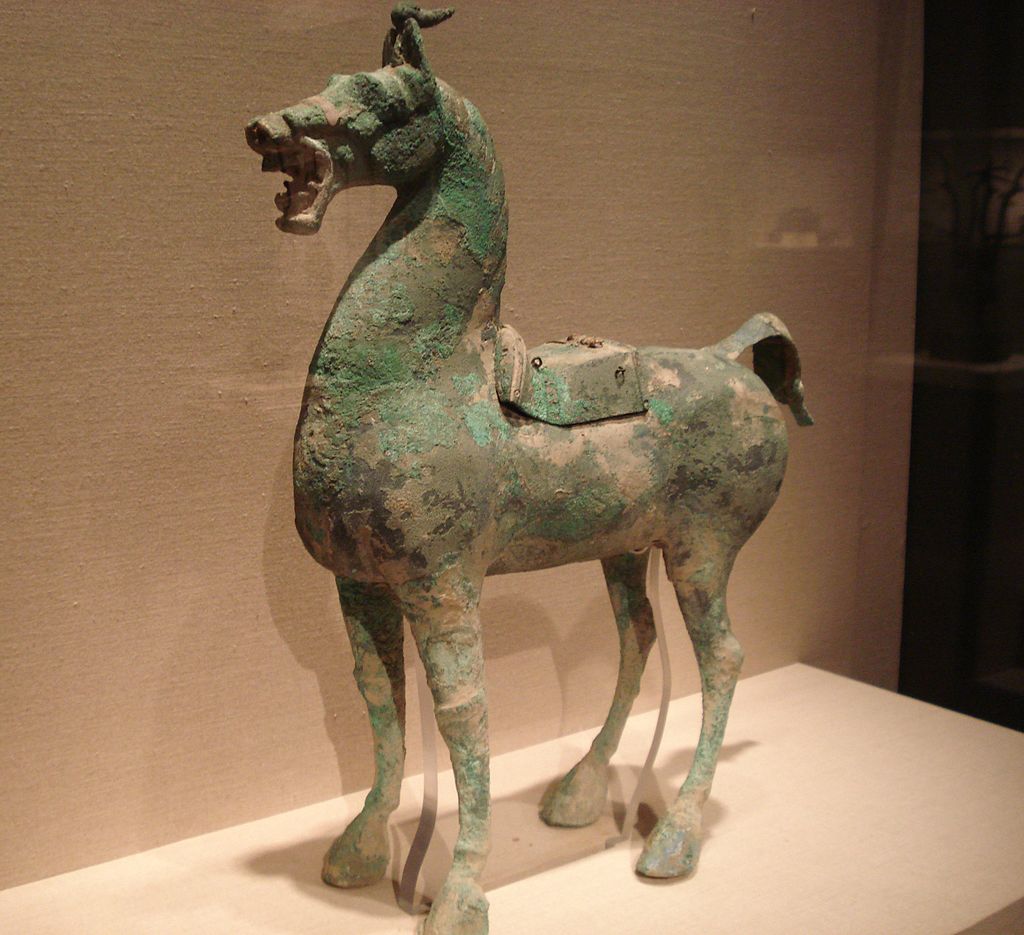
A trade mission arrived in Dayuan with 1000 pieces of gold and a golden horse to purchase these precious animals.
Dayuan, who was one of the furthest western states to send envoys to the Han court at that point, had already been trading with the Han for quite some time and benefited greatly from it. Not only were they overflowed by eastern goods, they also learned from Han soldiers how to cast metal into coins and weapons. However unlike the other envoys to the Han court, the ones from Dayuan did not conform to the proper Han rituals and behaved with great arrogance and self-assurance, believing they were too far away to be in any danger of invasion.
Hence, in a stroke of folly and taken by pure arrogance, the Dayuan king not only refused the deal, but confiscated the payment in gold. The Han envoys cursed the men of Dayuan and smashed the golden horse they had brought. Enraged by this act of contempt, the nobles of Dayuan ordered Yucheng, which lay on their eastern borders, to attack and kill the envoys and seize their goods.
Upon receiving word of the trade mission’s demise, humiliated and enraged, the Han court sent an army led by General Li Guangli to subdue Dayuan, but their first incursion was poorly organized and under-supplied.
A second, larger and much better provisioned expedition was sent two years later and successfully laid siege to the Dayuan capital at Alexandria Eschate, and forced Dayuan to surrender unconditionally.

The Han expeditionary forces installed a pro-Han regime in Dayuan and left with 3,000 horses, although only 1,000 remained by the time they reached China in 101 BCE.
The Ferghana also agreed to send two Heavenly horses each year to the Emperor, and lucerne seed was brought back to China providing superior pasture for raising fine horses in China, to provide cavalry which could cope with the Xiongnu who threatened China.
The horses have since captured the popular imagination of China, leading to horse carvings, breeding grounds in Gansu, and up to 430,000 such horses in the cavalry during the Tang dynasty.
China and the agricultural revolution
After imposing its role in military strategy for the next centuries, horsepower, together with water management, became a crucial factor to raise the productivity of the world’s food production.
First, contrary to the Romans, who preferred to use “human cattle” (slaves) rather than animals (which they raised for race contests), the Chinese greatly contributed to the survival of mankind with two crucial innovations respecting a more efficient use of horse power.
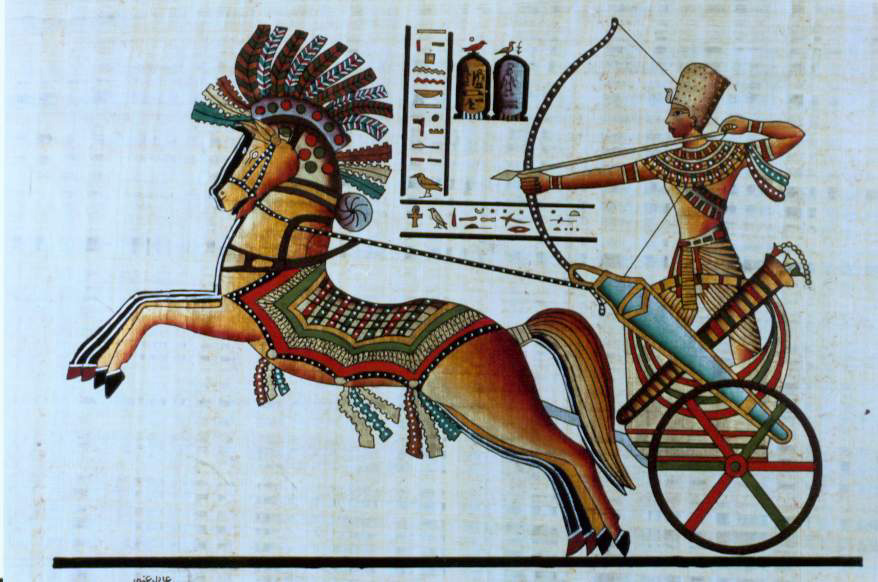
As can be seen in murals and paintings, through the ancient world, be it in Egypt or Greece, plows and carts were pulled using animal harnesses that had flat straps across the neck of the horse, with the load attached at the top of the collar, above the neck, in a manner similar to a yoke used for oxen.
In reality, this greatly limited a horse’s ability to exert itself as it was constantly choked at the neck. The harder the horse pulled, the harder it became to breathe.
Due to this physical limitation, oxen remained the preferred animal to do heavy work such as plowing. Yet oxen are hard to maneuver, are slow, and lack the quality of horses, whose power is equivalent but whose endurance is twice that of oxen.
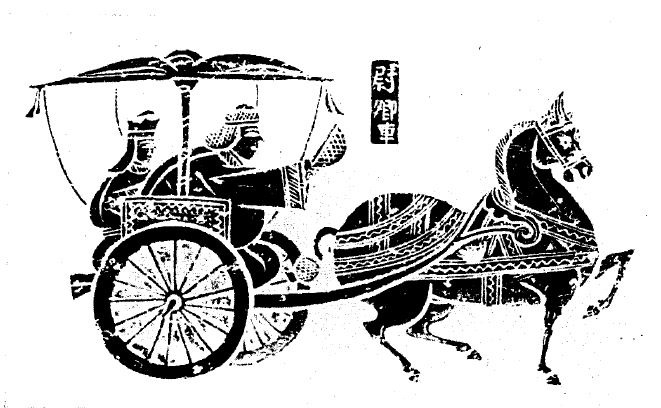
China reportedly first invented the “breast strap” which was the first step in the right direction.
Then, in the Vth Century, China also invented what is called the “rigid horse collar”, designed as an oval that fits around the neck and shoulders of the horse.

It has the following advantages:
–First, it relieved the pressure of the horse’s windpipes. It left the airway of the horse free from constriction improving massively the animal’s energy through-put.
–Second, the traces could be attached to the sides of the collar. This allowed the horse to push forward with its more powerful hind-legs rather than pulling with the weaker front legs.
Now you can argue that this is anecdotal. It is NOT, because what appears as only a slight change had absolutely monumental consequences.
European Renaissance

In a strategic alliance and cooperation with the humanist Baghdad Abbasid caliphate, Charlemagne and his successors introduced the “rigid horse collar” in Europe.
With that new, far more efficient tool, European farmers finally could take full advantage of a horse’s strength. The horse was able to pull another recent innovation, the heavy plow. This became particularly important in areas where the soil was hard and clay-like. This opened up new plots of lands to agriculture. The rigid horse collar, the heavy plow, and horseshoes helped usher in a period of increased agricultural production.
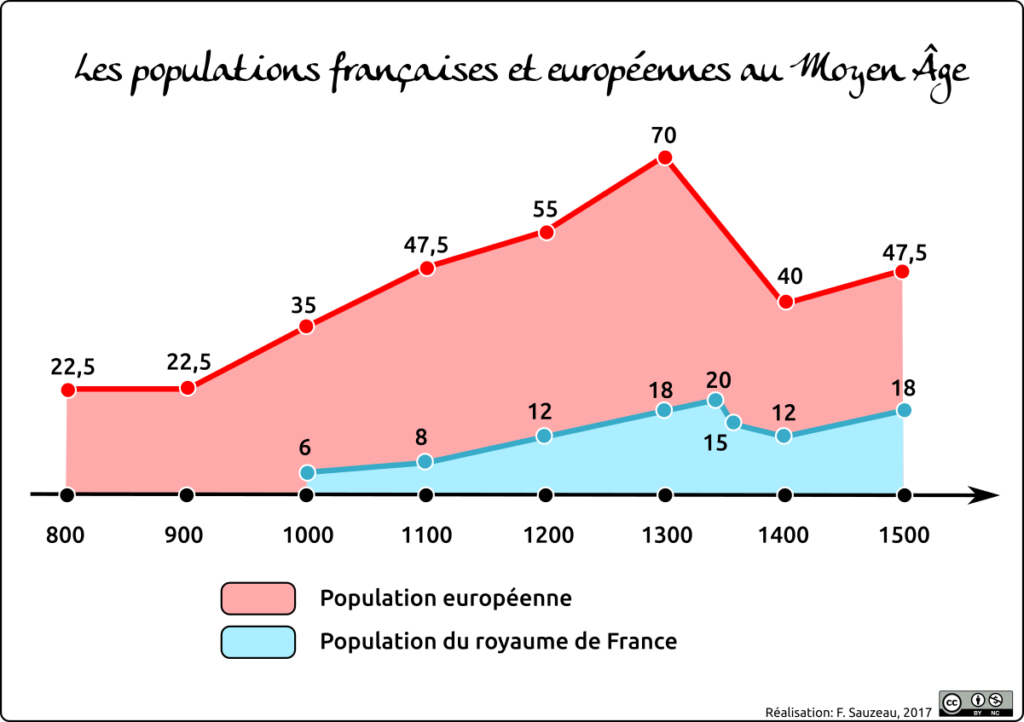
As a result, between 1000 CE and 1300 CE, it is estimated that in Europe, crop yields increased by threefold, allowing to feed a rising number of citizens in the urban cities appearing in the XVth century and kick starting the global “Golden” European Renaissance. Thank you, China!
Some numbers are nevertheless disturbing:
–it took humanity thousands of years to finally domesticate the horse (long after the cow), in 3200 BC.
–it took humanity another 3700 years to learn how to find out, in the Vth century AD, the most efficient way to use horse-power…
Shifting from a “lower” infrastructure platform to a “higher” infrastructure platform might take some time. Today’s new “higher” platforms are called “space data” and “fusion power.” Let’s not wait another century to find out how to use them correctly!
The republican struggle of David d’Angers and the statue of Gutenberg in Strasbourg

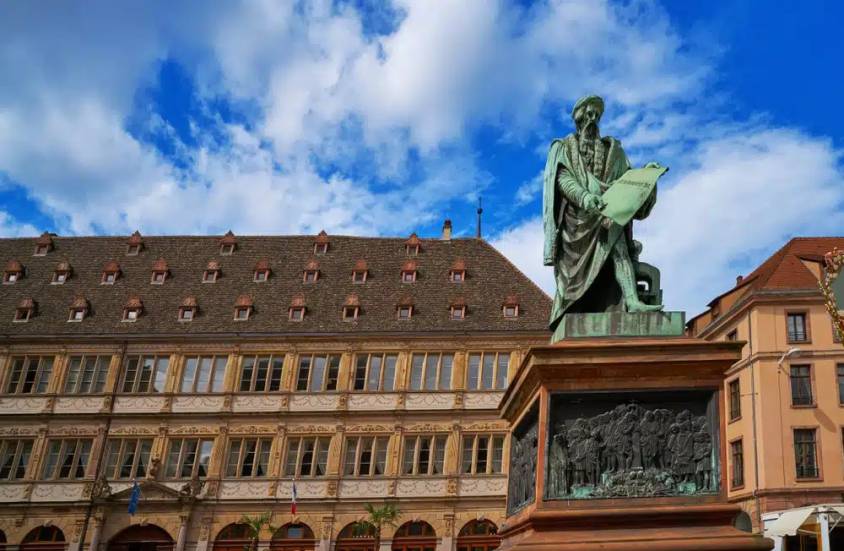
In the heart of downtown Strasbourg, a stone’s throw from the cathedral and with its back to the 1585 Chamber of Commerce, stands the beautiful bronze statue of the German printer Johannes Gutenberg, holding a barely-printed page from his Bible, which reads: « And there was light » (NOTE 1).
Evoking the emancipation of peoples thanks to the spread of knowledge through the development of printing, the statue, erected in 1840, came at a time when supporters of the Republic were up in arms against the press censorship imposed by Louis-Philippe under the July Monarchy.
Strasbourg, Mainz and China
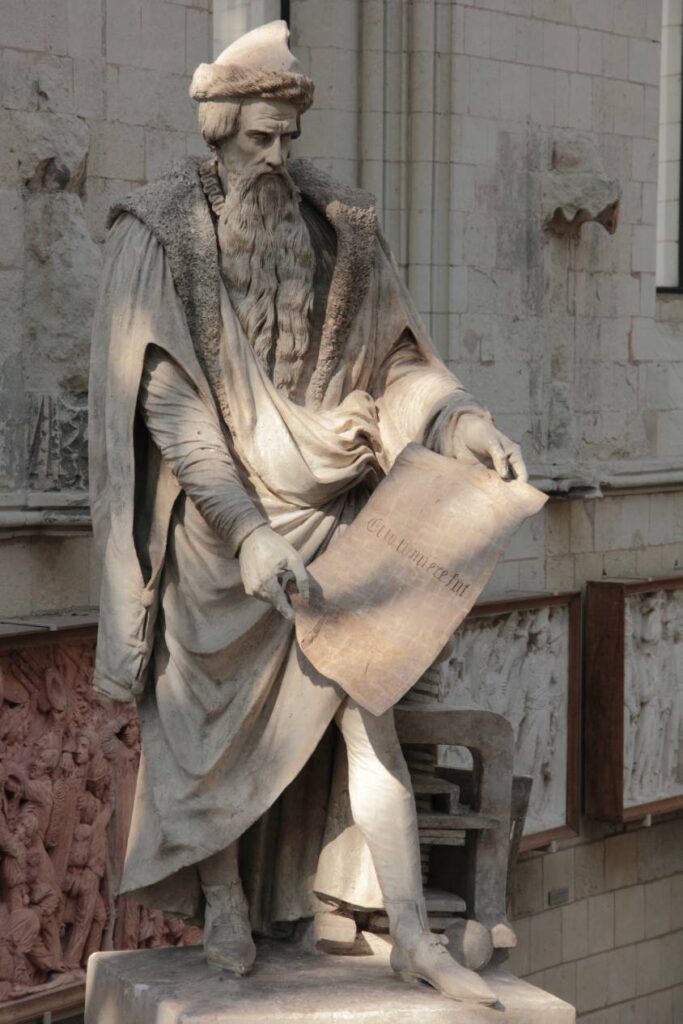
Born around 1400 in Mainz, Johannes Gutenberg, with money lent to him by the merchant and banker Johann Fust, carried out his first experiments with movable metal type in Strasbourg between 1434 and 1445, before perfecting his process in Mainz, notably by printing his famous 42-line Bible from 1452.
On his death (in Mainz) in 1468, Gutenberg bequeathed his process to humanity, enabling printing to take off in Europe. Chroniclers also mention the work of Laurens Janszoon Coster in Harlem, and the Italian printer Panfilo Castaldi, who is said to have brought Chinese know-how to Europe. It should be noted that the « civilized » world of the time refused to acknowledge that printing had originated in Asia with the famous « movable type » (made of porcelain and metal) developed several centuries earlier in China and Korea (NOTE 2).
In Europe, Mainz and Strasbourg vie for pride of place. On August 14, 1837, to celebrate the 400th anniversary of the « invention » of printing, Mainz inaugurated its statue of Gutenberg, erected by sculptor Bertel Thorvaldsenalors, while in Strasbourg, a local committee had already commissioned sculptor David d’Angers to create a similar monument in 1835.
This little-known sculptor was both a great sculptor and close friend of Victor Hugo, and a fervent republican in personal contact with the finest humanist elite of his time in France, Germany and the United States. He was also a tireless campaigner for the abolition of the slave trade and slavery.
The sculptor’s life
French sculptor Pierre-Jean David, known as « David d’Angers » (1788-1856) was the son of master sculptor Pierre Louis David. Pierre-Jean was influenced by the republican spirit of his father, who trained him in sculpture from an early age. At the age of twelve, his father enrolled him in the drawing class at the École Centrale de Nantes. In Paris, he was commissioned to create the ornamentation for the Arc de Triomphe du Carrousel and the south facade of the Louvre Palace. Finally, he entered the Beaux-arts.
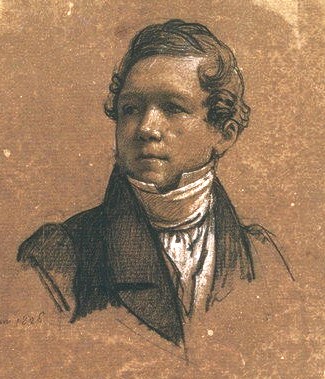
David d’Angers possessed a keen sense of interpretation of the human figure and an ability to penetrate the secrets of his models. He excelled in portraiture, whether in bust or medallion form. He is the author of at least sixty-eight statues and statuettes, some fifty bas-reliefs, a hundred busts and over five hundred medallions. Victor Hugo told his friend David: « This is the bronze coin by which you pay your toll to posterity. »
He traveled all over Europe, painting busts in Berlin, London, Dresden and Munich.
Around 1825, when he was commissioned to paint the funeral monument that the Nation was raising by public subscription in honor of General Foy, a tribune of the parliamentary opposition, he underwent an ideological and artistic transformation. He frequented the progressive intellectual circles of the « 1820 generation » and joined the international republican movement. He then turned his attention to the political and social problems of France and Europe. In later years, he remained faithful to his convictions, refusing, for example, the prestigious commission to design Napoleon’s tomb.
Artistic production

David’s art was thus influenced by a naturalism whose iconography and expression are in stark contrast to that of his academic colleagues and the dissident sculptors known as « romantics » at the time. For David, no mythological sensualism, obscure allegories or historical picturesqueness. On the contrary, sculpture, according to David, must generalize and transpose what the artist observes, so as to ensure the survival of ideas and destinies in a timeless posterity.
David adhered to this particular, limited conception of sculpture, adopting the Enlightenment view that the art of sculpture is « the lasting repository of the virtues of men », perpetuating the memory of the exploits of exceptional beings.
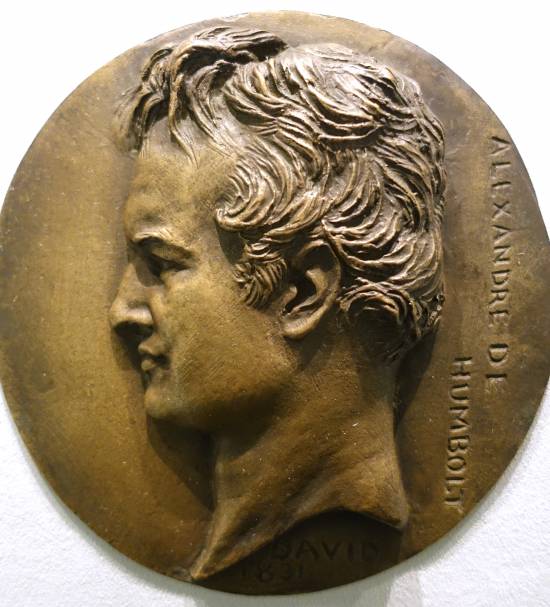
The somewhat austere image of « great men » prevailed, best known thanks to some 600 medallions depicting famous men and women from several countries, most of them contemporaries. Added to this are some one hundred busts, mostly of his friends, poets, writers, musicians, songwriters, scientists and politicians with whom he shared the republican ideal.
Among the most enlightened of his time were: Victor Hugo, Marquis de Lafayette, Wolfgang Goethe, Alfred de Vigny, Alphonse Lamartine, Pierre-Jean de Béranger, Alfred de Musset, François Arago, Alexander von Humboldt, Honoré de Balzac, Lady Morgan, James Fenimore Cooper, Armand Carrel, François Chateaubriand, Ennius Quirinus Visconti and Niccolo Paganini.
To magnify his models and visually render the qualities of each one’s genius, David d’Angers invented a mode of idealization no longer based on antique-style classicism, but on a grammar of forms derived from a new science, the phrenology of Doctor Gall, who believed that the cranial « humps » of an individual reflected his intellectual aptitudes and passions. For the sculptor, it was a matter of transcending the model’s physiognomy, so that the greatness of the soul radiated from his forehead.
In 1826, he was elected member of the Institut de France and, the same year, professor at the Beaux-Arts. In 1828, David d’Angers was the victim of his first unsolved assassination attempt. Wounded in the head, he was confined to bed for three months. However, in 1830, still loyal to republican ideas, he took part in the revolutionary days and fought on the barricades.
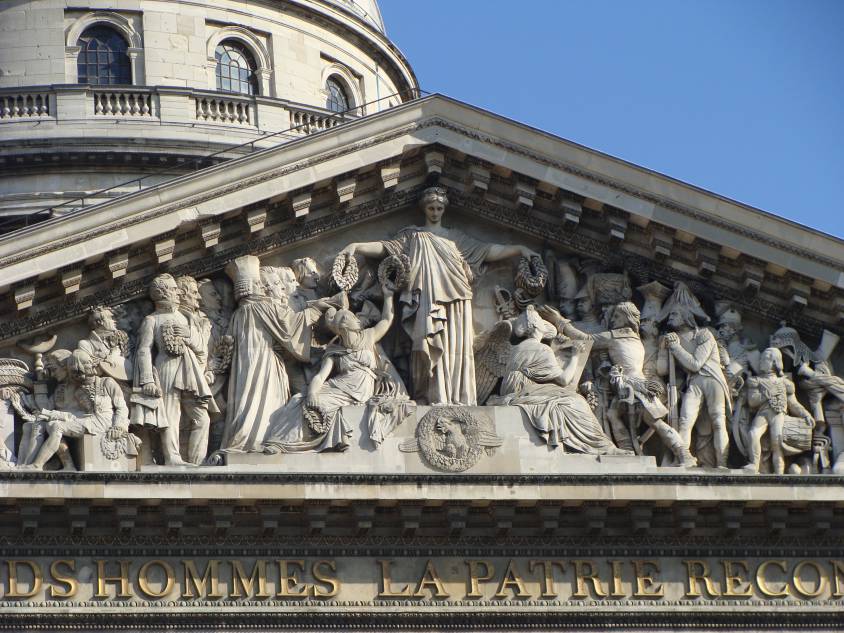
In 1830, David d’Angers found himself ideally placed to carry out the most significant political sculpture commission of the July monarchy and perhaps of 19th century France: the new decoration of the pediment of the church of Sainte-Geneviève, which had been converted into the Pantheon in July.
As a historiographer, he wanted to depict the civilians and men of war who built Republican France. In 1837, the execution of the figures he had chosen and arranged in a sketch that was first approved, then suspended, was bound to lead to conflict with the high clergy and the government. On the left, we see Bichat, Voltaire and Jean-Jacques Rousseau, David, Cuvier, Lafayette, Manuel, Carnot, Berthollet, Laplace, Malesherbes, Mirabeau, Monge and Fénelon. While the government tried to have Lafayette’s effigy removed, which David d’Angers stubbornly refused, with the support of the liberal press, the pediment was unveiled without official ceremony in September 1837, without the presence of the artist, who had not been invited.
Entering politics
During the 1848 Revolution, he was appointed mayor of the 11th arrondissement of Paris, entered the National Constituent Assembly and then the National Legislative Assembly, where he voted with the Montagne (revolutionary left). He defended the existence of the Ecole des Beaux-arts and the Académie de France in Rome. He opposed the destruction of the Chapelle Expiatoire and the removal of two statues from the Arc de Triomphe (Resistance and Peace by sculptor Antoine Etex).
He also voted against the prosecution of Louis Blanc (1811-1882) (another republican statesman and intellectual condemned to exile), against the credits for Napoleon III’s Roman expedition, for the abolition of the death penalty, for the right to work, and for a general amnesty.
Exile

He was not re-elected deputy in 1849 and withdrew from political life. In 1851, with the advent of Napoleon III, David d’Angers was arrested and also sentenced to exile. He chose Belgium, then traveled to Greece (his old project). He wanted to revisit his Greek Maiden on the tomb of the Greek republican patriot Markos Botzaris (1788-1823), which he found mutilated and abandoned (he had it repatriated to France and restored).
Disappointed by Greece, he returned to France in 1852. With the help of his friend de Béranger, he was allowed to stay in Paris, where he resumed his work. In September 1855, he suffered a stroke which forced him to cease his activities. He died in January 1856.
Friendships with Lafayette, Abbé Grégoire and Pierre-Jean de Béranger
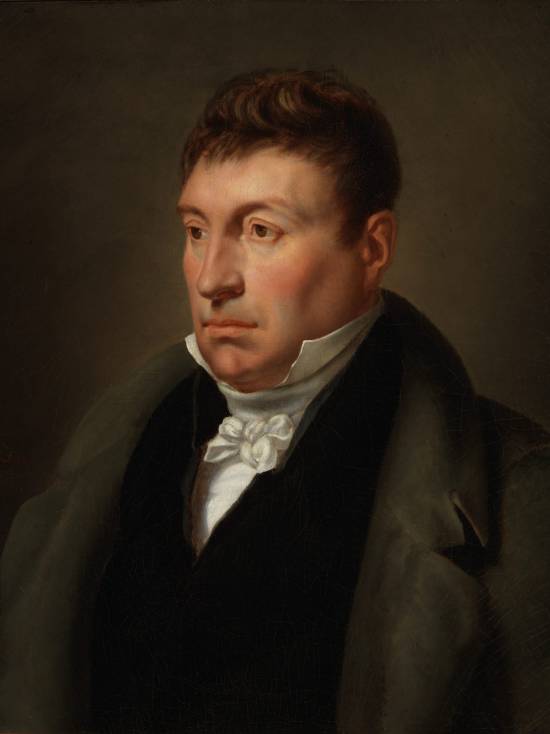
David d’Angers was a real link between 18th and 19th century republicans, and a living bridge between those of Europe and America.
Born in 1788, he had the good fortune to associate at an early age with some of the great revolutionary figures of the time, before becoming personally involved in the revolutions of 1830 and 1848.
Towards the end of the 1820s, David attended the Tuesday salon meetings of Madame de Lafayette, wife of Gilbert du Motier, Marquis de La Fayette (1757-1834).
While General Lafayette stood upright like « a venerable oak », this salon, notes the sculptor,
« has a clear-cut physiognomy, » he writes. The men talk about serious matters, especially politics, and even the young men look serious: there’s something decided, energetic and courageous in their eyes and in their posture (…) All the ladies and also the demoiselles look calm and thoughtful; they look as if they’ve come to see or attend important deliberations, rather than to be seen. »

David met Lafayette’s comrade-in-arms, General Arthur O’Connor (1763-1852), a former Irish republican MP of the United Irishmen who had joined Lafayette’s volunteer General Staff in 1792.
Accused of stirring up trouble against the British Empire and in contact with General Lazare Hoche (1768-1797), O’Connor fled to France in 1796 and took part in the Irish Expedition. In 1807, O’Connor married the daughter of philosopher and mathematician Nicolas de Condorcet (1743-1794) and became a naturalized French citizen in 1818.
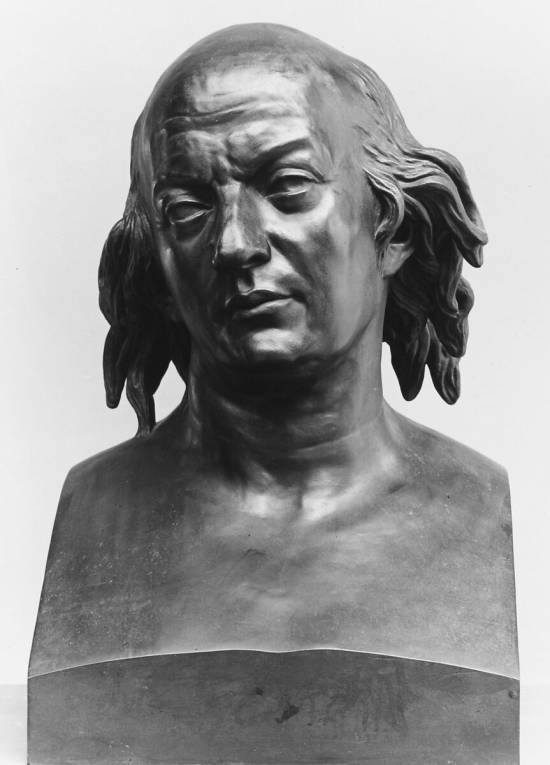
Lafayette and David d’Angers often got together with a small group of friends, a few « brothers » who were members of Masonic lodges: such as the chansonnier Pierre-Jean de Béranger, François Chateaubriand, Benjamin Constant, Alexandre Dumas (who corresponded with Edgar Allan Poe), Alphonse Lamartine, Henri Beyle dit Stendhal and the painters François Gérard and Horace Vernet.
In these same circles, David also became acquainted with Henri (Abbé) Grégoire (1750-1831), and the issue of the abolition of slavery, which Grégoire had pushed through on February 4, 1794, was often raised. In their exchanges, Lafayette liked to recall the words of his youthful friend Nicolas de Condorcet:
« Slavery is a horrible barbarism, if we can only eat sugar at this price, we must know how to renounce a commodity stained with the blood of our brothers. »
For Abbé Gregoire, the problem went much deeper:
« As long as men are thirsty for blood, or rather, as long as most governments have no morals, as long as politics is the art of deceit, as long as people, unaware of their true interests, attach silly importance to the job of spadassin, and will allow themselves to be led blindly to the slaughter with sheep-like resignation, almost always to serve as a pedestal for vanity, almost never to avenge the rights of humanity, and to take a step towards happiness and virtue, the most flourishing nation will be the one that has the greatest facility for slitting the throats of others. »
(Essay on the physical, moral and political regeneration of the Jews)
Napoleon and slavery
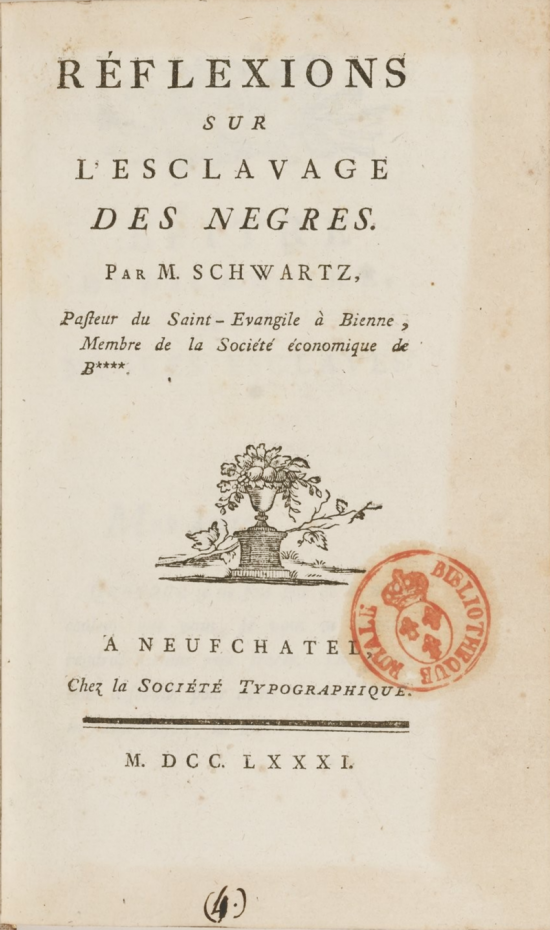
The first abolition of slavery was, alas, short-lived. In 1802, Napoleon Bonaparte, short of the money needed to finance his wars, reintroduced slavery, and nine days later excluded colored officers from the French army.
Finally, he outlawed marriages between « fiancés whose skin color is different ». David d’Angers remained very sensitive to this issue, having as a comrade a very young writer, Alexandre Dumas, whose father had been born a slave in Haiti.
As early as 1781, under the pseudonym Schwarz (black in German), Condorcet had published a manifesto advocating the gradual disappearance of slavery over a period of 60 to 70 years, a view quickly shared by Lafayette. A fervent supporter of the abolitionist cause, Condorcet condemned slavery as a crime, but also denounced its economic uselessness: slave labor, with its low productivity, was an obstacle to the establishment of a market economy.
And even before the signing of the peace treaty between France and the United States, Lafayette wrote to his friend George Washington on February 3, 1783, proposing to join him in setting in motion a process of gradual emancipation of the slaves. He suggested a plan that would « frankly become beneficial to the black portion of mankind ».
The idea was to buy a small state in which to experiment with freeing slaves and putting them to work as farmers. Such an example, he explained, « could become a school and thus a general practice ». (NOTE 3)
Washington replied that he personally would have liked to support such a step, but that the American Congress (already) was totally hostile.
From the Society of Black Friends to the French Society for the Abolition of Slavery

In Paris, on February 19, 1788, Abbé Grégoire and Jacques Pierre Brissot (1754-1793) founded « La Société des amis des Noirs », whose rules were drawn up by Condorcet, and of which the Lafayette couple were also members.
The society’s aim was the equality of free whites and blacks in the colonies, the immediate prohibition of the black slave trade and the gradual abolition of slavery; on the one hand, to maintain the economy of the French colonies, and on the other, in the belief that before blacks could achieve freedom, they had to be prepared for it, and therefore educated.
After the virtual disappearance of the « Amis des Noirs », the offensive was renewed, with the founding in 1821 of the « Société de la Morale chrétienne », which in 1822 set up a « Comité pour l’abolition de la traite des Noirs », some of whose members went on to found the « Société française pour l’abolition de l’esclavage (SFAE) » in 1834.
Initially in favor of gradual abolition, the SFAE later favored immediate abolition. Prohibited from holding meetings, the SFAE decided to create abolitionist committees throughout the country to relay the desire to put an end to slavery, both locally and nationally.
Goethe and Schiller
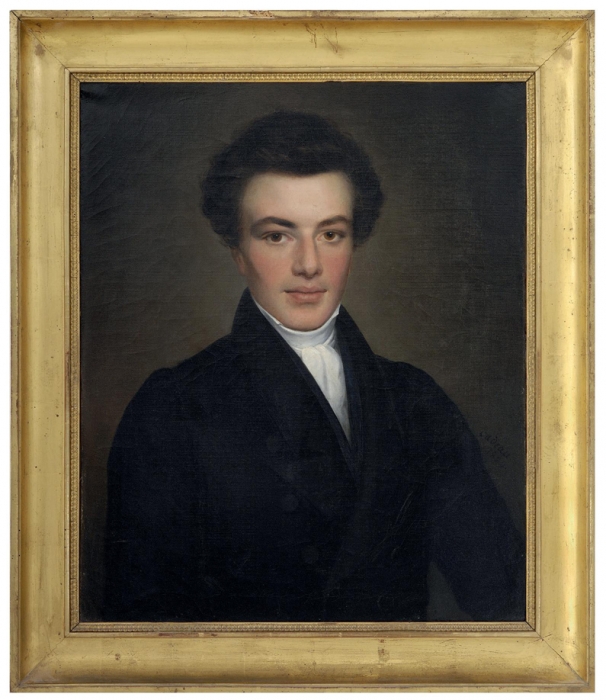
In the summer of 1829, David d’Angers made his first trip to Germany and met Goethe (1749-1832), the poet and philosopher who had retired to Weimar. Several posing sessions enabled the sculptor to complete his portrait.
Writer and poet Victor Pavie (1808-1886), a friend of Victor Hugo and one of the founders of the « Cercles catholiques ouvriers » (Catholic Workers Circle), accompagnied him on the trip and recounts some of the pictoresques anecdotes of their travel in his « Goethe and David, memories of a voyage to Weimar » (1874).
In 1827, the French newspaper Globe published two letters recounting two visits to Goethe, in 1817 and 1825, by an anonymous « friend » (Victor Cousin), as well as a letter from Ampère on his return from the « Athens of Germany ». In these letters, the young scientist expressed his admiration, and gave numerous details that whetted the interest of his compatriots. During his stay in Weimar, Ampère added to his host’s knowledge of Romantic authors, particularly Mérimée, Vigny, Deschamps and Delphine Gay. Goethe already had a (positive) opinion of Victor Hugo, Lamartine and Casimir Delavigne, and of all they owed to Chateaubriand.
A subscriber to the Globe since its foundation in 1824, Goethe had at his disposal a marvellous instrument of French information. In any case, he had little left to learn about France when David and Pavie visited him in August 1829. On the strength of his unhappy experience with Walter Scott in London, David d’Angers had taken precautions this time, and had a number of letters of recommendation for the people of Weimar, as well as two letters of introduction to Goethe, signed by Abbé Grégoire and Victor Cousin. To show the illustrious writer what he could do, he had placed some of his finest medallions in a crate.
Once in Weimar, David d’Angers and Victor Pavie encountered great difficulties in their quest, especially as the recipients of the letters of recommendation were all absent. Stricken with despair and fearing failure, David blamed his young friend Victor Pavie:
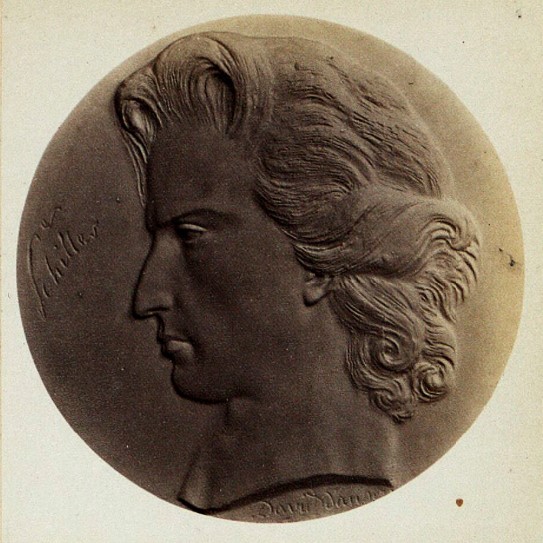
« Yes, you jumped in with the optimism of a young man, without giving me time to think and get out of the way. It wasn’t as a coward or under the patronage of an adventurer, it was head-on and resolutely that we had to tackle the character. (…) You’re only as good as what you are, it’s a yes or no question. You know me, on my knees before genius, and imployable before power. Ah! court poets, great or small, everywhere the same!
(…) And with a leap from the chair where he had insensitively let himself fall: Where’s Schiller? I’d like to kiss him! His grave, where I will strike, will not remain sealed for me; I will take him there, and bring him back glorious. What does it matter? Have I seen Corneille, have I seen Racine? The bust I’m planning for him will look all the better for it; the flash of his genius will gleam on his forehead. I’ll make him as I love and admire him, not with the pinched nose that Dannecker (image below) gave him, but with nostrils swollen with patriotism and freedom.
Victor Pavie’s account reveals the republican fervor animating the sculptor who, faithful to the ideals of Abbé Grégoire, was already thinking about the great anti-slavery sculpture he planned to create:
« At that moment, the half-open window of our bedroom, yielding to the evening breeze, opened wide. The sky was superb; the Milky Way unfurled with such brilliance that one could have counted the stars. He (David) remained silent for some time, dazzled; then, with that suddenness of impression that incessantly renewed the realm of feelings and ideas around him:
‘What a work, what a masterpiece! How poor we are compared to this!Would all your geniuses in one, writers, artists, poets, ever reach this incomparable poem whose tasks are splendors? Yet God knows your insatiable pretensions; we flay you in praise… And light! Remember this (and his presentiments in this regard were nothing less than a chimera), that such a one as received a marble bust from me as a token of my admiration, will one day literally lose the memory of it. – No, there is nothing more noble and great in humanity than that which suffers. I still have in my head, or rather in my heart, this protest of the human conscience against the most execrable iniquity of our times, the slave trade: after ten years of silence and suffering, it must burst forth with the voice of brass. You can see the group from here: the garroted slave, his eye on the sky, protector and avenger of the weak; next to him, lying broken, his wife, in whose bosom a frail creature is sucking blood instead of milk; at their feet, detached from the negro’s broken collar, the crucifix, the Man-God who died for his brothers, black or white. Yes, the monument will be made of bronze, and when the wind blows, you will hear the chain beating, and the rings ringing' ».
Finally, Goethe met the two Frenchmen, and David d’Angers succeeded in making his bust of the German poet. Victor Pavie:
« Goethe bowed politely to us, spoke the French language with ease from the start, and made us sit down with that calm, resigned air that astonished me, as if it were a simple thing to find oneself standing at eighty, face to face with a third generation, to which he had passed on through the second, like a living tradition.
(…) David carried with him, as the saying goes, a sample of his skills.He presented the old man with a few of his lively profiles, so morally expressive, so nervously and intimately executed, part of a great whole that is becoming more complete with our age, and which reserves for the centuries to come the monumental physiognomy of the 19th century. Goethe took them in his hand, considered them mute, with scrupulous attention, as if to extract some hidden harmony, and let out a muffled, equivocal exclamation that I later recognized as a mark of genuine satisfaction.Then, by a more intelligible and flattering transition, of which he was perhaps unaware, walking to his library, he charmingly showed us a rich collection of medals from the Middle Ages, rare and precious relics of an art that could be said to have been lost, and of which our great sculptor David has nowadays been able to recover and re-immerse the secret.
(…) The bust project did not have to languish for long: the very next day, one of the apartments in the poet’s immense house was transformed into a workshop, and a shapeless mound lay on the parquet floor, awaiting the first breath of existence. As soon as it slowly shifted into a human form, Goethe’s hitherto calm and impassive figure moved with it. Gradually, as if a secret, sympathetic alliance had developed between portrait and model, as the one moved towards life, the other blossomed into confidence and abandonment: we soon came to those artist’s confidences, that confluence of poetry, where the ideas of the poet and the sculptor come together in a common mold. He would come and go, prowling around this growing mass, (to use a trivial comparison) with the anxious solicitude of a landowner building a house. He asked us many questions about France, whose progress he was following with a youthful and active curiosity; and frolicking at leisure about modern literature, he reviewed Chateaubriand, Lamartine, Nodier, Alfred de Vigny, Victor Hugo, whose manner he had seriously pondered in Cromwell.
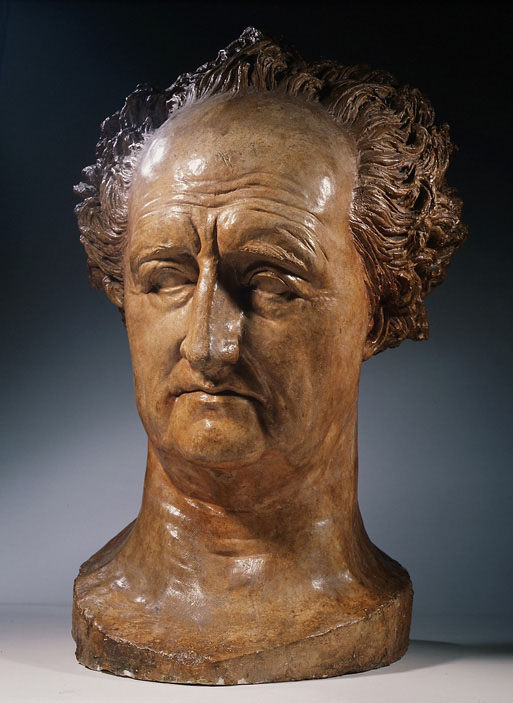

(…) David’s bust, writes Pavie, was as beautiful as Chateaubriand’s, Lamartine’s, Cooper’s, as any application of genius to genius, as the work of a chisel fit and powerful to reproduce one of those types created expressly by nature for the habitation of a great thought. Of all the likenesses attempted, with greater or lesser success, in all the ages of this long glory, from his youth of twenty to Rauch’s bust, the last and best understood of all, it is no prevention to say that David’s is the best, or, to put it even more bluntly, the only realization of that ideal likeness which is not the thing, but is more than the thing, nature taken within and turned inside out, the outward manifestation of a divine intelligence passed into human bark. And there are few occasions like this one, when colossal execution seems no more than a powerless indication of real effect. An immense forehead, on which rises, like clouds, a thick tuft of silver hair; a downward gaze, hollow and motionless, a look of Olympian Jupiter; a nose of broad proportion and antique style, in the line of the forehead ; then that singular mouth we were talking about earlier, with the lower lip a little forward, that mouth, all examination, questioning and finesse, completing the top with the bottom, genius with reason; with no other pedestal than its muscular neck, this head leans as if veiled, towards the earth:it’s the hour when the setting genius lowers his gaze to this world, which he still lights with a farewell ray. Such is David’s crude description of Goethe’s statue.- What a pity that in his bust of Schiller, so famous and so praised, the sculptor Dannecker prepared such a miserable counterpart!
When Goethe received his bust, he warmly thanked David for the exchange of letters, books and medallions… but made no mention of the bust ! For one simple reason: he didn’t recognize himself at all in the work, which he didn’t even keep at home… The German poet was depicted with an oversized forehead, to reflect his great intelligence. And his tousled hair symbolized the torments of his soul…
David d’Angers and Hippolyte Carnot

Among the founders of the SFAE (see earlier chapter on Abbé Grégoire) was Hippolyte Carnot (1801-1888), younger brother of Nicolas Sadi Carnot (1796-1832), pioneer of thermodynamics and son of « the organizer of victory », the military and scientific genius Lazare Carnot (1753-1823), whose work and struggle he recounted in his 1869 biography Mémoires sur Lazare Carnot 1753-1823 by his son Hippolyte.
In 1888, with the title Henri Grégoire, évêque (bishop) républicain, Hippolyte published the Mémoires of Grégoire the defender of all the oppressed of the time (negroes and Jews alike), a great friend of his father’s who had retained this friendship.
For the former bishop of Blois, « we must enlighten the ignorance that does not know and the poverty that does not have the means to know. »
Grégoire had been one of the Convention’s great « educators », and it was on his report that the Conservatoire des Arts-et-Métiers was founded on September 29, 1794, notably for the instruction of craftsmen. Grégoire also contributed to the creation of the Bureau des Longitudes on June 25, 1795 and the Institut de France on October 25, 1795.
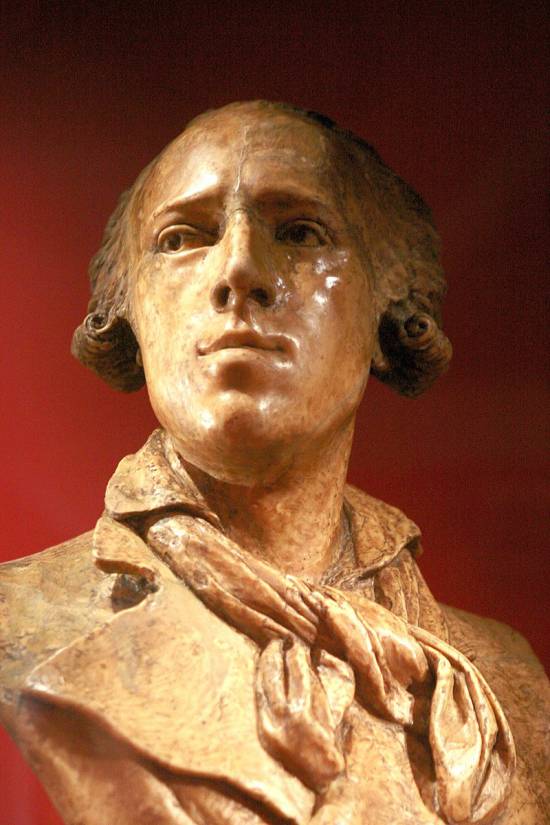
Hippolyte Carnot and David d’Angers, who were friends, co-authored the Memoirs of Bertrand Barère de Vieuzac (1755-1841), who acted as a sort of Minister of Information on the Comité de Salut Public, responsible for announcing the victories of the Republican armies to the Convention as soon as they arrived.
It was also Abbé Grégoire who, in 1826, commissioned David d’Angers, with the help of his friend Béranger, to bring some material and financial comfort to Rouget de Lisle (1860-1836), the legendary author of La Marseillaise, composed in Strasbourg when, in his old age, the composer was languishing in prison for debt.
Overcoming the sectarianism of their time, here are three fervent republicans full of compassion and gratitude for a musical genius who never wanted to renounce his royalist convictions, but whose patriotic creation would become the national anthem of the young French Republic.
Provisional Government
of the Second Republic

All these battles, initiatives and mobilizations culminated in 1848, when, for two months and 15 days (from February 24 to May 9), a handful of genuine republicans became part of the « provisional government » of the Second Republic.
In such a short space of time, so many good measures were taken or launched! Hippolyte Carnot was the Minister of Public Instruction, determined to create a high level of education for all, including women, following the models set by his father for Polytechnique and Grégoire for Arts et Métiers.
Article 13 of the 1848 Constitution « guarantees citizens (…) free primary education ».
On June 30, 1848, the Minister of Public Instruction, Lazare Hippolyte Carnot, submitted a bill to the Assembly that fully anticipated the Ferry laws, by providing for compulsory elementary education for both sexes, free and secular, while guaranteeing freedom of teaching. It also provided for three years’ free training at a teacher training college, in return for an obligation to teach for at least ten years, a system that was to remain in force for a long time. He proposed a clear improvement in their salaries. He also urged teachers « to teach a republican catechism ».
A member of the provisional government, the great astronomer and scientist François Arago (1886-1853) was Minister for the Colonies, having been appointed by Gaspard Monge to succeed him at the Ecole Polytechnique, where he taught projective geometry. His closest friend was none other than Alexander von Humboldt, friend of Johann Wolfgang Goethe and Friedrich Schiller.
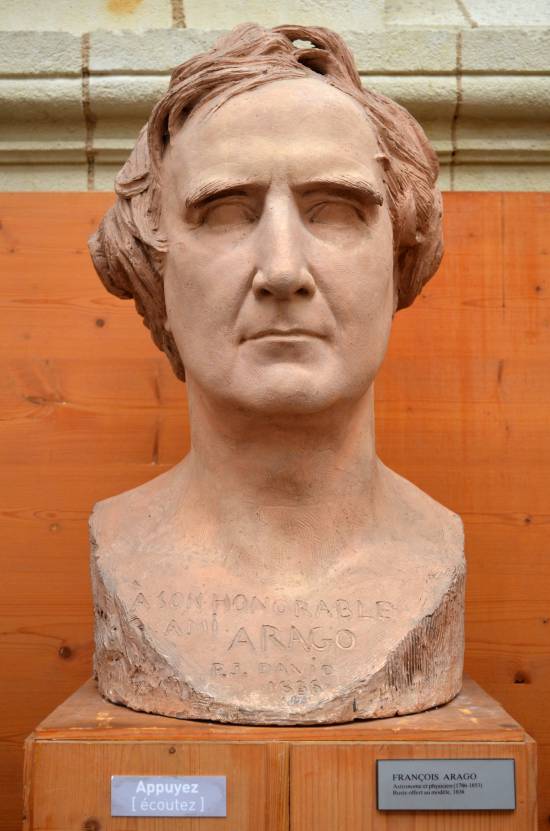
He was another abolitionist activist who spent much of his adult life in Paris. Humboldt was a member of the Société d’Arcueil, formed around the chemist Claude-Louis Berthollet, where he also met, besides François Arago, Jean-Baptiste Biot and Louis-Joseph Gay-Lussac, with whom Humboldt became friends. They published several scientific articles together.
Humboldt and Gay-Lussac conducted joint experiments on the composition of the atmosphere, terrestrial magnetism and light diffraction, research that would later bear fruit for the great Louis Pasteur.
Napoleon, who initially wanted to expel Humboldt, eventually tolerated his presence. The Paris Geographical Society, founded in 1821, chose him as its president.
Humboldt, Arago, Schoelcher, David d’Angers and Hugo

Humboldt made no secret of his republican ideals. His Political Essay on the Island of Cuba (1825) was a bombshell. Too hostile to slavery practices, the work was banned from publication in Spain. London went so far as to refuse him access to its Empire.
Even more deplorably, John S. Trasher, who published an English-language version in 1856, removed the chapter devoted to slaves and the slave trade altogether! Humboldt protested vigorously against this politically motivated mutilation. Trasher was a slaveholder, and his redacted translation was intended to counter the arguments of North American abolitionists, who subsequently published the retracted chapter in the New York Herald and the US Courrier. Victor Schoelcher and the decree abolishing slavery in the French colonies.
In France, under Arago, the Under-Secretary of State for the Navy and the Colonies was Victor Schoelcher. He didn’t need much convincing to convince the astronomer that all the planets were aligned for him to act.
A Freemason, Schoelcher was a brother of David d’Angers’s lodge, « Les amis de la Vérité » (The Friends of Truth), also known as the Cercle social, in reality « a mixture of revolutionary political club, Masonic lodge and literary salon ».
On March 4, a commission was set up to resolve the problem of slavery in the French colonies. It was chaired by Victor de Broglie, president of the SFAE, to which five of the commission’s twelve members belonged. Thanks to the efforts of François Arago, Henri Wallon and above all Victor Schoelcher, its work led to the abolition of slavery on April 27.
Victor Hugo the abolitionist

Victor Hugo was one of the advocates of the abolition of slavery in France, but also of equality between what were still referred to as « the races » in the 19th century. « The white republic and the black republic are sisters, just as the black man and the white man are brothers », Hugo asserted as early as 1859. For him, as all men were creations of God, brotherhood was the order of the day.
When Maria Chapman, an anti-slavery campaigner, wrote to Hugo on April 27, 1851, asking him to support the abolitionist cause, Hugo replied: « Slavery in the United States! » he exclaimed on May 12, « is there any more monstrous misinterpretation? » How could a republic with such a fine constitution preserve such a barbaric practice?
Eight years later, on December 2, 1859, he wrote an open letter to the United States of America, published by the free newspapers of Europe, in defense of the abolitionist John Brown, condemned to death.
Starting from the fact that « there are slaves in the Southern states, which indignifies, like the most monstrous counter-sense, the logical and pure conscience of the Northern states », he recounts Brown’s struggle, his trial and his announced execution, and concludes: « there is something more frightening than Cain killing Abel, it is Washington killing Spartacus ».
A journalist from Port-au-Prince, Exilien Heurtelou, thanked him on February 4, 1860. Hugo replied on March 31:
« Hauteville-House, March 31, 1860.
You are, sir, a noble sample of this black humanity so long oppressed and misunderstood.
From one end of the earth to the other, the same flame is in man; and blacks like you prove it. Was there more than one Adam? Naturalists can debate the question, but what is certain is that there is only one God.
Since there is only one Father, we are brothers.
It is for this truth that John Brown died; it is for this truth that I fight. You thank me for this, and I can’t tell you how much your beautiful words touch me.
There are neither whites nor blacks on earth, there are spirits; you are one of them. Before God, all souls are white.
I love your country, your race, your freedom, your revolution, your republic. Your magnificent, gentle island pleases free souls at this hour; it has just set a great example; it has broken despotism. It will help us break slavery. »
Also in 1860, the American Abolitionist Society, mobilized behind Lincoln, published a collection of speeches. The booklet opens with three texts by Hugo, followed by those by Carnot, Humboldt and Lafayette.
On May 18, 1879, Hugo agreed to preside over a commemoration of the abolition of slavery in the presence of Victor Schoelcher, principal author of the 1848 emancipation decree, who hailed Hugo as « the powerful defender of all the underprivileged, all the weak, all the oppressed of this world » and declared:
« The cause of the Negroes whom we support, and towards whom the Christian nations have so much to reproach, must have had your sympathy; we are grateful to you for attesting to it by your presence in our midst. »
A start for the better
Another measure taken by the provisional government of this short-lived Second Republic was the abolition of the death penalty in the political sphere, and the abolition of corporal punishment on March 12, as well as imprisonment for debt on March 19.
In the political sphere, freedom of the press and freedom of assembly were proclaimed on March 4. On March 5, the government instituted universal male suffrage, replacing the censal suffrage in force since 1815. At a stroke, the electorate grew from 250,000 to 9 million. This democratic measure placed the rural world, home to three quarters of the population, at the heart of political life for many decades to come. This mass of new voters, lacking any real civic training, saw in him a protector, and voted en masse for Napoleon III in 1851, 1860 and 1870.
Victor Hugo

To return to David d’Angers, a lasting friendship united him with Victor Hugo (1802-1885). Recently married, Hugo and David would meet to draw. The poet and the sculptor enjoyed drawing together, making caricatures, painting landscapes or « architectures » that inspired them.
A shared ideal united them, and with the arrival of Napoleon III, both men went into political exile.
Out of friendship, David d’Angers made several busts of his friend. Hugo is shown wearing an elegant contemporary suit.
His broad forehead and slightly frowning eyebrows express the poet’s greatness, yet to come. Refraining from detailing the pupils, David lends this gaze an inward, pensive dimension that prompted Hugo to write: « my friend, you are sending me immortality. »
In 1842, David d’Angers produced another bust of Victor Hugo, crowned with laurel, where this time it was not Hugo the close friend who was evoked, but rather the genius and great man.
Finally, for Hugo’s funeral in 1885, the Republic of Haiti wished to show its gratitude to the poet by sending a delegation to represent it. Emmanuel-Edouard, a Haitian writer, presided over the delegation, and made the following statement at the Pantheon:
The Republic of Haiti has the right to speak on behalf of the black race; the black race, through me, thanks Victor Hugo for having loved and honored it so much, for having strengthened and comforted it.
The four bas-reliefs
of the Gutenberg statue
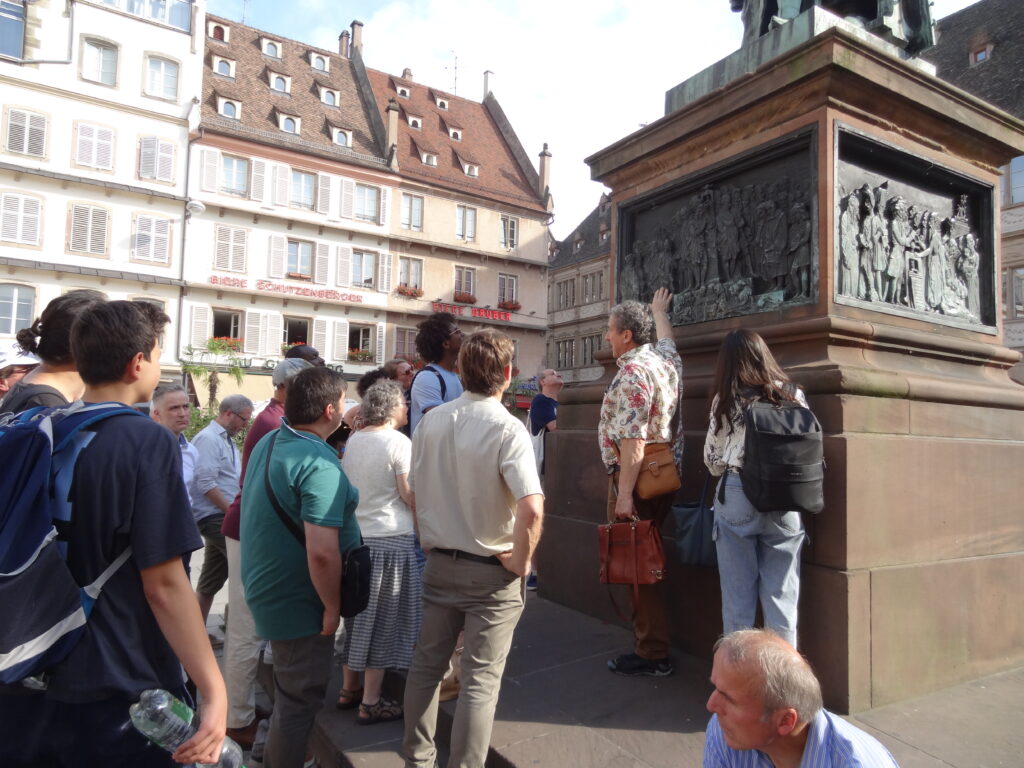
Once the reader has identified this « great arch » that runs through history, and the ideas and convictions that inspired David d’Angers, he will grasp the beautiful unity underlying the four bas-reliefs on the base of the statue commemorating Gutenberg in Strasbourg.
What stands out is the very optimistic idea that the human race, in all its great and magnificent diversity, is one and fraternal. Once freed from all forms of oppression (ignorance, slavery, etc.), they can live together in peace and harmony.
These bronze bas-reliefs were added in 1844. After bitter debate and contestation, they replaced the original 1840 painted plaster models affixed at the inauguration. They represent the benefits of printing in America, Africa, Asia and Europe. At the center of each relief is a printing press surrounded by characters identified by inscriptions, as well as schoolteachers, teachers and children.
To conclude, here’s an extract from the inauguration report describing the bas-reliefs. Without falling into wokism (for whom any idea of a « great man » is necessarily to be fought), let’s point out that it is written in the terms of the time and therefore open to discussion:

Plaster model for the base of the statue of Gutenberg, David d’Angers.
« Europe
is represented by a bas-relief featuring René Descartes in a meditative attitude, beneath Francis Bacon and Herman Boerhaave. On the left are William Shakespeare, Pierre Corneille, Molière and Racine. One row below, Voltaire, Buffon, Albrecht Dürer, John Milton and Cimarosa, Poussin, Calderone, Camoëns and Puget. On the right, Martin Luther, Wilhelm Gottfried Leibniz, Immanuel Kant, Copernicus, Wolfgang Goethe, Friedrich Schiller, Hegel, Richter, Klopstock. Rejected on the side are Linné and Ambroise Parée. Near the press, above the figure of Martin Luther, Erasmus of Rotterdam, Rousseau and Lessing. Below the tier, Volta, Galileo, Isaac Newton, James Watt, Denis Papin and Raphaël. A small group of children study, including one African and one Asian.«
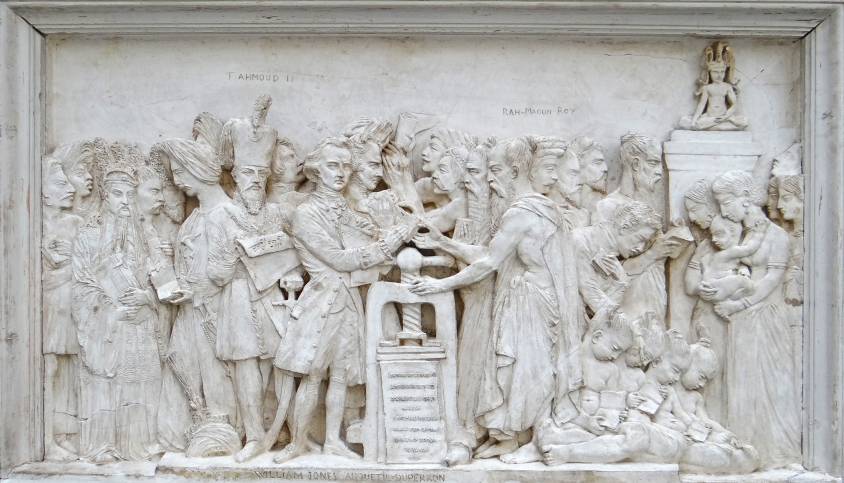
Plaster model for the base of the statue of Gutenberg, David d’Angers.
« Asia.
A printing press is shown again, with William Jones and Abraham Hyacinthe Anquetil-Duperron offering books to Brahmins, who give them manuscripts in return. Near Jones, Sultan Mahmoud II is reading the Monitor in modern clothes, his old turban lies at his feet, and nearby a Turk is reading a book. One step below, a Chinese emperor surrounded by a Persian and a Chinese man is reading the Book of Confucius. A European instructs children, while a group of Indian women stand by an idol and the Indian philosopher Rammonhun-Roy.«
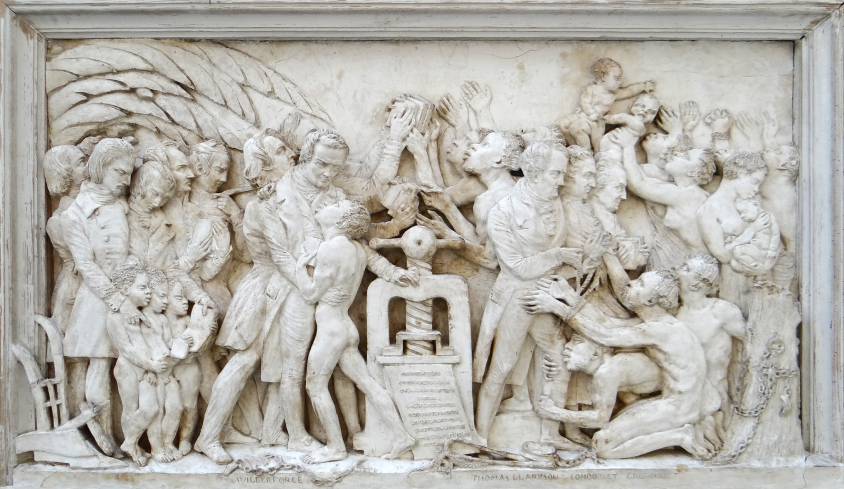
« Africa.
Leaning on a press, William Wilberforce hugs an African holding a book, while Europeans distribute books to other Africans and are busy teaching children. On the right, Thomas Clarkson can be seen breaking the shackles of a slave. Behind him, Abbé Grégoire helps a black man to his feet and holds his hand over his heart. A group of women raise their recovered children to the sky, which will now see only free men, while on the ground lie broken whips and irons. This is the end of slavery.«
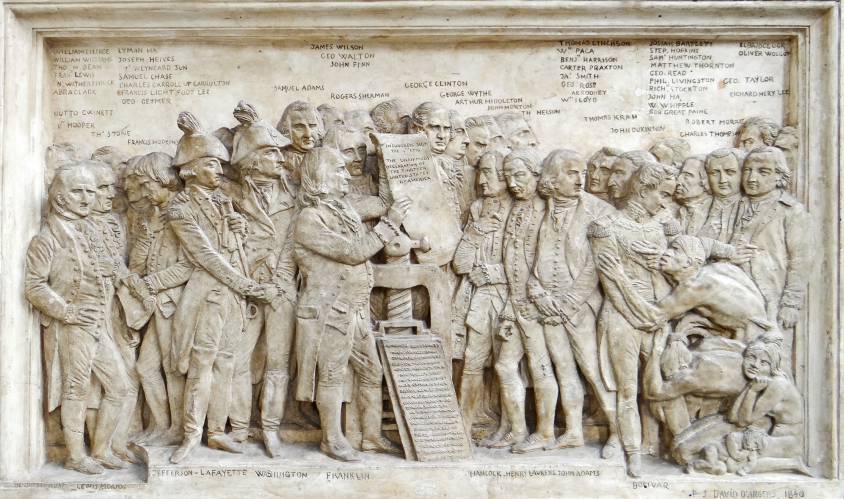
« America.
The Act of Independence of the United States, fresh from the press, is in the hands of Benjamin Franklin. Next to him stand Washington and Lafayette, who holds the sword given to him by his adopted homeland to his chest. Jefferson and all the signatories of the Act of Independence are assembled. On the right, Bolivar shakes hands with an Indian. »
America

We can better understand the words spoken by Victor Hugo on November 29, 1884, shortly before his death, during his visit to the workshop of sculptor Frédéric-Auguste Bartholdi, where the poet was invited to admire the giant statue bearing the symbolic name « Liberty Enlightening the World », built with the help of Gustave Eiffel and ready to leave for the United States by ship. A gift from France to America, it will commemorate the active part played by Lafayette’s country in the Revolutionary War.
Initially, Hugo was most interested in American heroes and statesmen: William Penn, Benjamin Franklin, John Brown and Abraham Lincoln. Role models, according to Hugo, who enabled the people to progress. For the French politician who became a Republican in 1847, America was the example to follow. Even if he was very disappointed by the American position on the death penalty and slavery.
After 1830, the writer abandoned this somewhat idyllic vision of the New World and attacked the white « civilizers » who hunted down Indians:
« You think you civilize a world, when you inflame it with some foul fever [4], when you disturb its lakes, mirrors of a secret god, when you rape its virgin, the forest. When you drive out of the wood, out of the den, out of the shore, your naive and dark brother, the savage… And when throwing out this useless Adam, you populate the desert with a man more reptilian… Idolater of the dollar god, madman who palpitates, no longer for a sun, but for a nugget, who calls himself free and shows the appalled world the astonished slavery serving freedom!«
(NOTE 5)
Overcoming his fatigue, in front of the Statue of Liberty, Hugo improvised what he knew would be his last speech:
« This beautiful work tends towards what I have always loved, called: peace between America and France – France which is Europe – This pledge of peace will remain permanent. It was good that it was done!«
NOTES:
1. If the phrase appears in the Book of Genesis, it could also refer to Notre-Dame de Paris (1831) a novel by Victor Hugo, a great friend of the statue’s sculptor, David d’Angers. We know from a letter Hugo wrote in August 1832 that the poet brought David d’Angers the eighth edition of the book. The scene most directly embodied in the statue is the one in which the character of Frollo converses with two scholars (one being Louis XI in disguise) while pointing with one finger to a book and with the other to the cathedral, remarking: « Ceci tuera cela » (This will kill that), i.e. that one power (the printed press), democracy, will supplant the other (the Church), theocracy, a historical evolution Hugo thought ineluctable.
2. It was the encounter with Asia that brought countless technical know-how and scientific discoveries from the East to Europe, the best-known being the compass and gunpowder. Just as essential to printing as movable type was paper, the manufacture of which was perfected in China at the end of the Eastern Han Dynasty (around the year 185). As for printing, the oldest printed book we have to date is the Diamond Sutra, a Chinese Buddhist scripture dating from 868. Finally, it was in the mid-11th century, under the Song dynasty, that Bi Sheng (990-1051) invented movable type. Engraved in porcelain, a viscous clay ceramic, hardened in fire and assembled in resin, they revolutionized printing. As documented by the Gutenberg Museum in Mainz, it was the Korean Choe Yun-ui (1102-1162) who improved this technique in the 12th century by using metal (less fragile), a process later adopted by Gutenberg and his associates. The Anthology of Zen Teachings of Buddhist High Priests (1377), also known as the Jikji, was printed in Korea 78 years before the Gutenberg Bible, and is recognized as the world’s oldest book with movable metal type.
3. Etienne Taillemite, Lafayette and the abolition of slavery.
4. Victor Hugo undoubtedly wanted to rebound on the news that reached him from America. The Pacific Northwest smallpox epidemic of 1862, which was brought from San Francisco to Victoria, devastated the indigenous peoples of the Pacific Northwest coast, with a mortality rate of over 50% along the entire coast from Puget Sound to southeast Alaska. Some historians have described the epidemic as a deliberate genocide, as the colony of Vancouver Island and the colony of British Columbia could have prevented it, but chose not to, and in a way facilitated it.
5. Victor Hugo, La civilisation from Toute la lyre (1888 and 1893).
Rembrandt’s oil painting is back… in China?
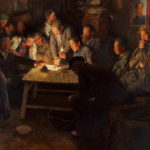

While in the West, “modern” artistic expression has degenerated into vibrant eulogies on the “Eros/Thanatos” theme (sex/death), Chinese artists have been encouraged to revive the most uplifting forms of art, often combining classical universal geniuses with their own historic traditions.
A case in point is Wang Shaolun (born 1968), whose “realistic” paintings, including beautiful portraits of women, are rejected by western critiques as remnants of “social realism”. It is true that, even when the country is rapidly becoming an industrial giant and urban residents become richer and richer, this young artist continues depicting farmers.
Following his graduation from the Beijing Central Academy of Fine Arts, Shaolin, sponsored by the Chinese government, could finish his training at the world famous Repin Art Academy of Saint-Petersburg. Recently, Shaolin was commissioned by the Chinese government to paint several life-size oil paintings for museums in major cities, as well as for national celebratory events.
On Nov. 18, CGTN, presented Shaolun’s 1999 work titled: « Xiaogang, The Night Of November 24, 1978 » depicting a night scene in a rural farming village in Anhui Province. “That evening, 18 farmers signed an agreement that would change the course of agriculture in China.” writes CGTN. Before 1978, China practiced collective farming. But food shortages due to drought, lack of incentives and other challenges were persistent.
The historical accord was called « The Household Responsibility System (HRS)” and for the first time all allowed individual households to contract land and machinery to produce their own yields. With this new procedure, “Each household sold the government their grain at an official price. But any leftover grain could be sold on the open market at a much higher price.” The new system was one of the key reforms of Deng Xiaoping and a key step of pulling millions out of extreme poverty. As a result, between 1978 and 1984, agricultural output in China almost doubled. The HRS resolved the food scarcity crisis and elevated incomes.
The painting is clearly inspired by Rembrandt’s 1661 oil painting called the “Conspiracy of Claudius Civilis” with the light literately emanating out of the table and illuminating a group of peasants intensively concentrating on accomplishing an act that’s going to change the course of history.
Krsta Paskovic: canal building from China to Serbia


In 2013, at the World Canal Conference in Toulouse, France, Karel Vereycken interviews Serbian, Chinese and Italian experts and historians on the important role of canals.

